Marketing Strategy and Plan
VerifiedAdded on 2023/03/17
|20
|5843
|50
AI Summary
This document discusses the marketing strategy and plan of AirAsia, including a SWOT analysis and macro-environmental analysis. It explores the strengths, weaknesses, opportunities, and threats of the company. The document also covers the PESTEL analysis and Porter's Five Forces model. Find study material and solved assignments on Desklib.
Contribute Materials
Your contribution can guide someone’s learning journey. Share your
documents today.
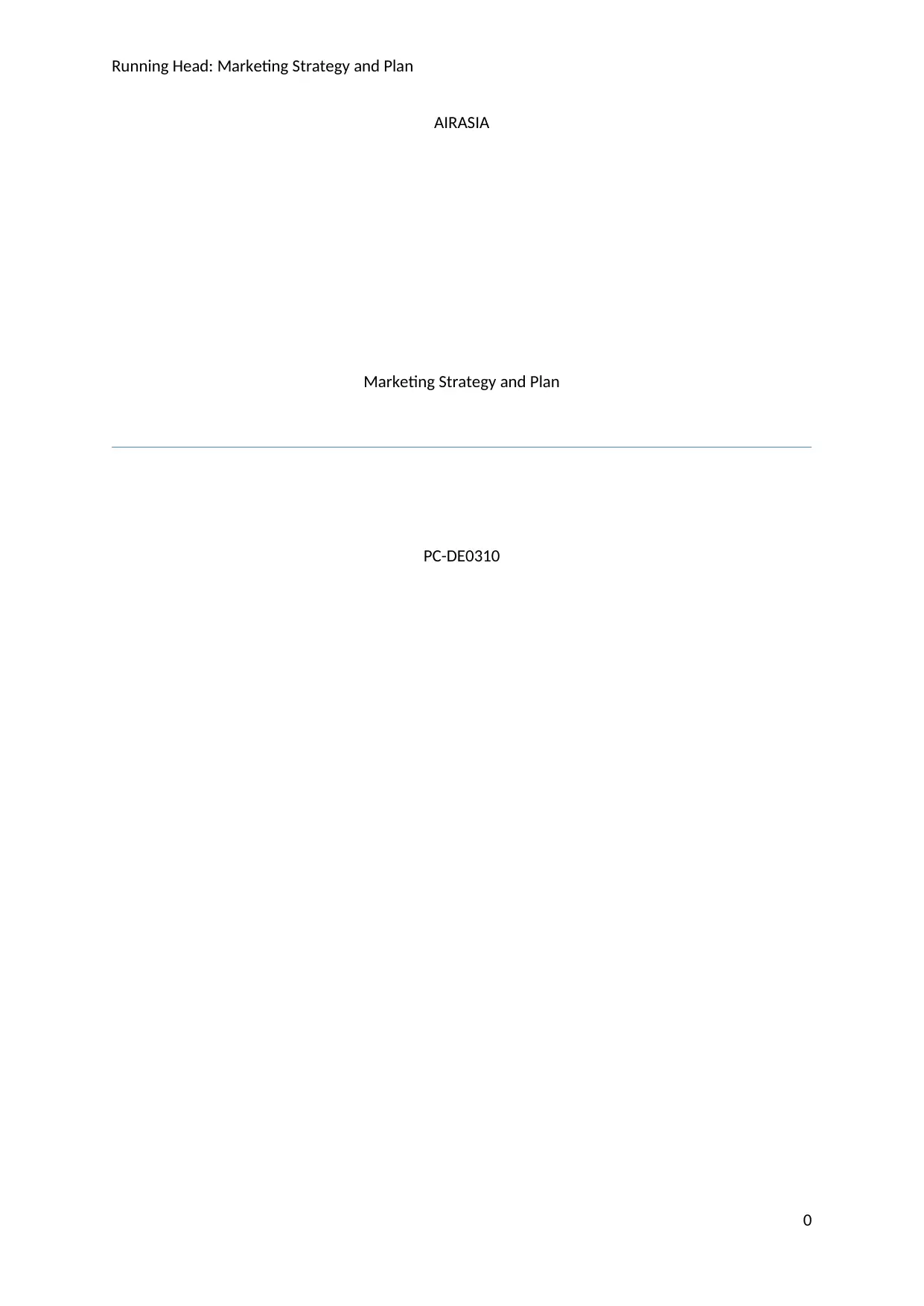
Running Head: Marketing Strategy and Plan
AIRASIA
Marketing Strategy and Plan
PC-DE0310
0
AIRASIA
Marketing Strategy and Plan
PC-DE0310
0
Secure Best Marks with AI Grader
Need help grading? Try our AI Grader for instant feedback on your assignments.

Marketing Strategy and Plan
Contents
Executive Summary...............................................................................................................................2
INTRODUCTION.....................................................................................................................................2
SWOT analysis of Air Asia......................................................................................................................3
Strengths in the SWOT analysis of Air Asia.....................................................................................3
Weaknesses in the SWOT analysis of Air Asia.................................................................................4
Opportunities in the SWOT analysis of Air Asia...............................................................................5
Threats in the SWOT analysis of Air Asia.........................................................................................5
MACRO-ENVIRONMENTAL ANALYSIS....................................................................................................6
PESTEL.............................................................................................................................................6
Porter ’s Five Forces Industry Analysis...................................................................................................7
Section 2..............................................................................................................................................10
Conclusion...........................................................................................................................................12
References...........................................................................................................................................14
1
Contents
Executive Summary...............................................................................................................................2
INTRODUCTION.....................................................................................................................................2
SWOT analysis of Air Asia......................................................................................................................3
Strengths in the SWOT analysis of Air Asia.....................................................................................3
Weaknesses in the SWOT analysis of Air Asia.................................................................................4
Opportunities in the SWOT analysis of Air Asia...............................................................................5
Threats in the SWOT analysis of Air Asia.........................................................................................5
MACRO-ENVIRONMENTAL ANALYSIS....................................................................................................6
PESTEL.............................................................................................................................................6
Porter ’s Five Forces Industry Analysis...................................................................................................7
Section 2..............................................................................................................................................10
Conclusion...........................................................................................................................................12
References...........................................................................................................................................14
1
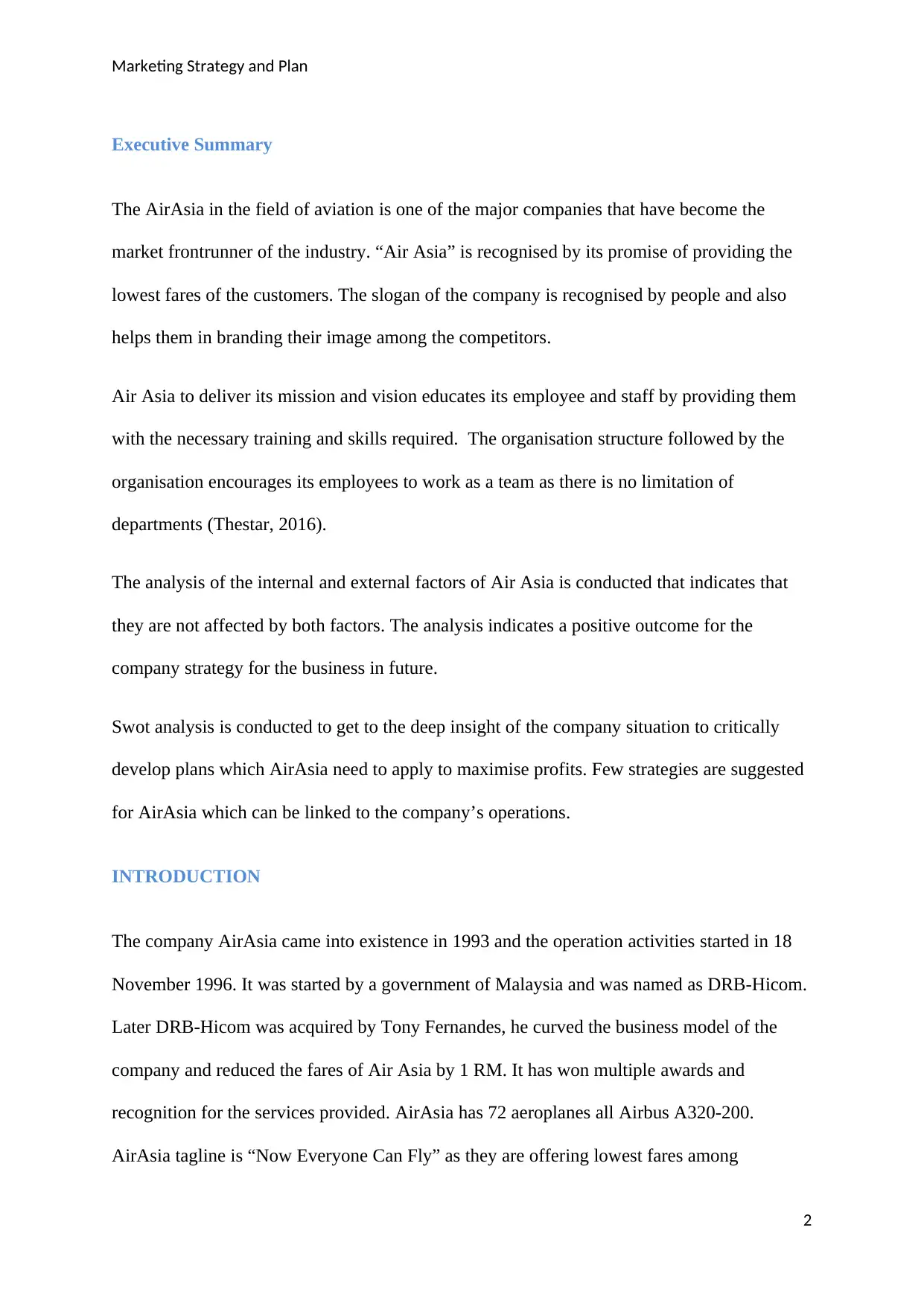
Marketing Strategy and Plan
Executive Summary
The AirAsia in the field of aviation is one of the major companies that have become the
market frontrunner of the industry. “Air Asia” is recognised by its promise of providing the
lowest fares of the customers. The slogan of the company is recognised by people and also
helps them in branding their image among the competitors.
Air Asia to deliver its mission and vision educates its employee and staff by providing them
with the necessary training and skills required. The organisation structure followed by the
organisation encourages its employees to work as a team as there is no limitation of
departments (Thestar, 2016).
The analysis of the internal and external factors of Air Asia is conducted that indicates that
they are not affected by both factors. The analysis indicates a positive outcome for the
company strategy for the business in future.
Swot analysis is conducted to get to the deep insight of the company situation to critically
develop plans which AirAsia need to apply to maximise profits. Few strategies are suggested
for AirAsia which can be linked to the company’s operations.
INTRODUCTION
The company AirAsia came into existence in 1993 and the operation activities started in 18
November 1996. It was started by a government of Malaysia and was named as DRB-Hicom.
Later DRB-Hicom was acquired by Tony Fernandes, he curved the business model of the
company and reduced the fares of Air Asia by 1 RM. It has won multiple awards and
recognition for the services provided. AirAsia has 72 aeroplanes all Airbus A320-200.
AirAsia tagline is “Now Everyone Can Fly” as they are offering lowest fares among
2
Executive Summary
The AirAsia in the field of aviation is one of the major companies that have become the
market frontrunner of the industry. “Air Asia” is recognised by its promise of providing the
lowest fares of the customers. The slogan of the company is recognised by people and also
helps them in branding their image among the competitors.
Air Asia to deliver its mission and vision educates its employee and staff by providing them
with the necessary training and skills required. The organisation structure followed by the
organisation encourages its employees to work as a team as there is no limitation of
departments (Thestar, 2016).
The analysis of the internal and external factors of Air Asia is conducted that indicates that
they are not affected by both factors. The analysis indicates a positive outcome for the
company strategy for the business in future.
Swot analysis is conducted to get to the deep insight of the company situation to critically
develop plans which AirAsia need to apply to maximise profits. Few strategies are suggested
for AirAsia which can be linked to the company’s operations.
INTRODUCTION
The company AirAsia came into existence in 1993 and the operation activities started in 18
November 1996. It was started by a government of Malaysia and was named as DRB-Hicom.
Later DRB-Hicom was acquired by Tony Fernandes, he curved the business model of the
company and reduced the fares of Air Asia by 1 RM. It has won multiple awards and
recognition for the services provided. AirAsia has 72 aeroplanes all Airbus A320-200.
AirAsia tagline is “Now Everyone Can Fly” as they are offering lowest fares among
2
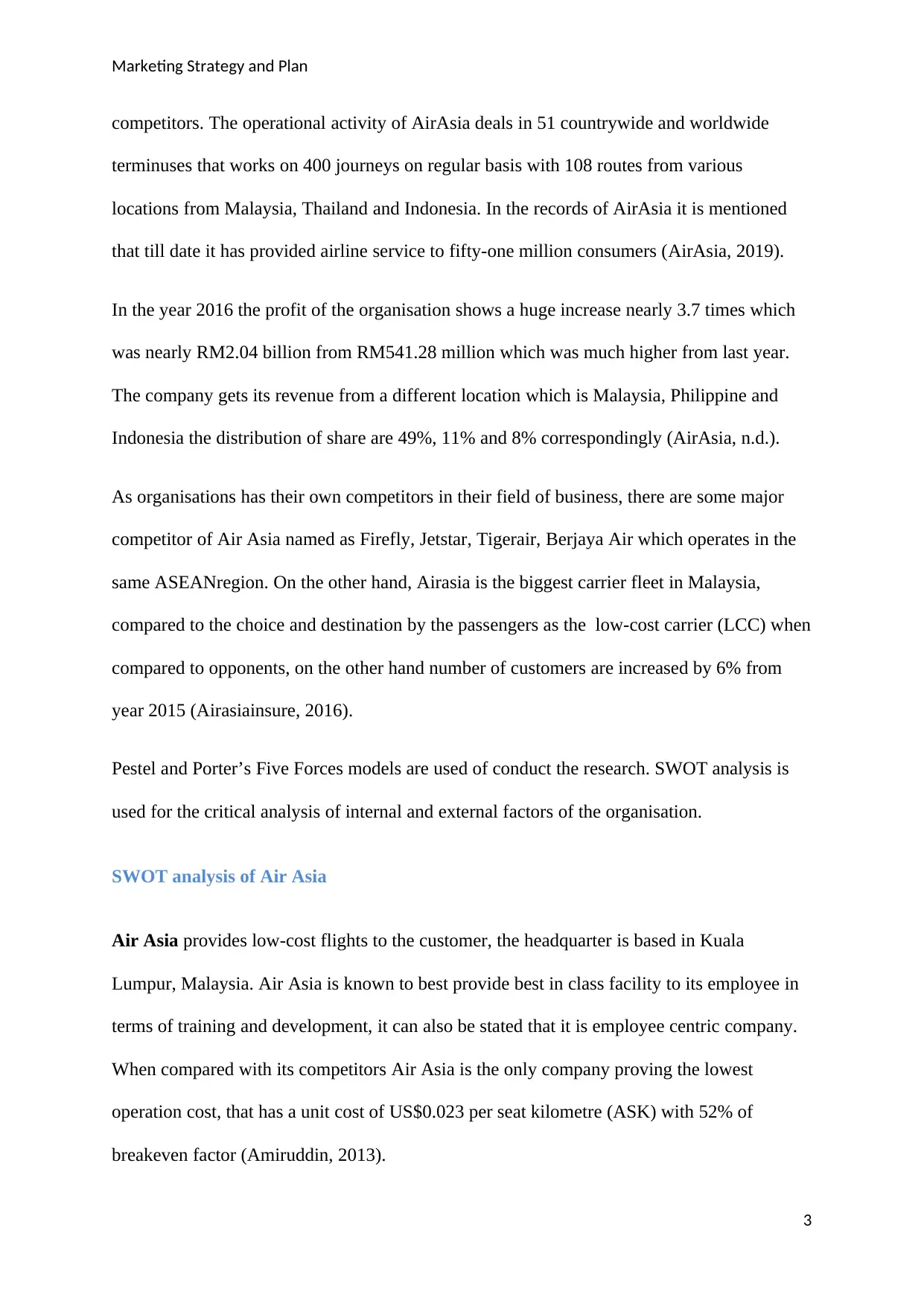
Marketing Strategy and Plan
competitors. The operational activity of AirAsia deals in 51 countrywide and worldwide
terminuses that works on 400 journeys on regular basis with 108 routes from various
locations from Malaysia, Thailand and Indonesia. In the records of AirAsia it is mentioned
that till date it has provided airline service to fifty-one million consumers (AirAsia, 2019).
In the year 2016 the profit of the organisation shows a huge increase nearly 3.7 times which
was nearly RM2.04 billion from RM541.28 million which was much higher from last year.
The company gets its revenue from a different location which is Malaysia, Philippine and
Indonesia the distribution of share are 49%, 11% and 8% correspondingly (AirAsia, n.d.).
As organisations has their own competitors in their field of business, there are some major
competitor of Air Asia named as Firefly, Jetstar, Tigerair, Berjaya Air which operates in the
same ASEANregion. On the other hand, Airasia is the biggest carrier fleet in Malaysia,
compared to the choice and destination by the passengers as the low-cost carrier (LCC) when
compared to opponents, on the other hand number of customers are increased by 6% from
year 2015 (Airasiainsure, 2016).
Pestel and Porter’s Five Forces models are used of conduct the research. SWOT analysis is
used for the critical analysis of internal and external factors of the organisation.
SWOT analysis of Air Asia
Air Asia provides low-cost flights to the customer, the headquarter is based in Kuala
Lumpur, Malaysia. Air Asia is known to best provide best in class facility to its employee in
terms of training and development, it can also be stated that it is employee centric company.
When compared with its competitors Air Asia is the only company proving the lowest
operation cost, that has a unit cost of US$0.023 per seat kilometre (ASK) with 52% of
breakeven factor (Amiruddin, 2013).
3
competitors. The operational activity of AirAsia deals in 51 countrywide and worldwide
terminuses that works on 400 journeys on regular basis with 108 routes from various
locations from Malaysia, Thailand and Indonesia. In the records of AirAsia it is mentioned
that till date it has provided airline service to fifty-one million consumers (AirAsia, 2019).
In the year 2016 the profit of the organisation shows a huge increase nearly 3.7 times which
was nearly RM2.04 billion from RM541.28 million which was much higher from last year.
The company gets its revenue from a different location which is Malaysia, Philippine and
Indonesia the distribution of share are 49%, 11% and 8% correspondingly (AirAsia, n.d.).
As organisations has their own competitors in their field of business, there are some major
competitor of Air Asia named as Firefly, Jetstar, Tigerair, Berjaya Air which operates in the
same ASEANregion. On the other hand, Airasia is the biggest carrier fleet in Malaysia,
compared to the choice and destination by the passengers as the low-cost carrier (LCC) when
compared to opponents, on the other hand number of customers are increased by 6% from
year 2015 (Airasiainsure, 2016).
Pestel and Porter’s Five Forces models are used of conduct the research. SWOT analysis is
used for the critical analysis of internal and external factors of the organisation.
SWOT analysis of Air Asia
Air Asia provides low-cost flights to the customer, the headquarter is based in Kuala
Lumpur, Malaysia. Air Asia is known to best provide best in class facility to its employee in
terms of training and development, it can also be stated that it is employee centric company.
When compared with its competitors Air Asia is the only company proving the lowest
operation cost, that has a unit cost of US$0.023 per seat kilometre (ASK) with 52% of
breakeven factor (Amiruddin, 2013).
3
Secure Best Marks with AI Grader
Need help grading? Try our AI Grader for instant feedback on your assignments.
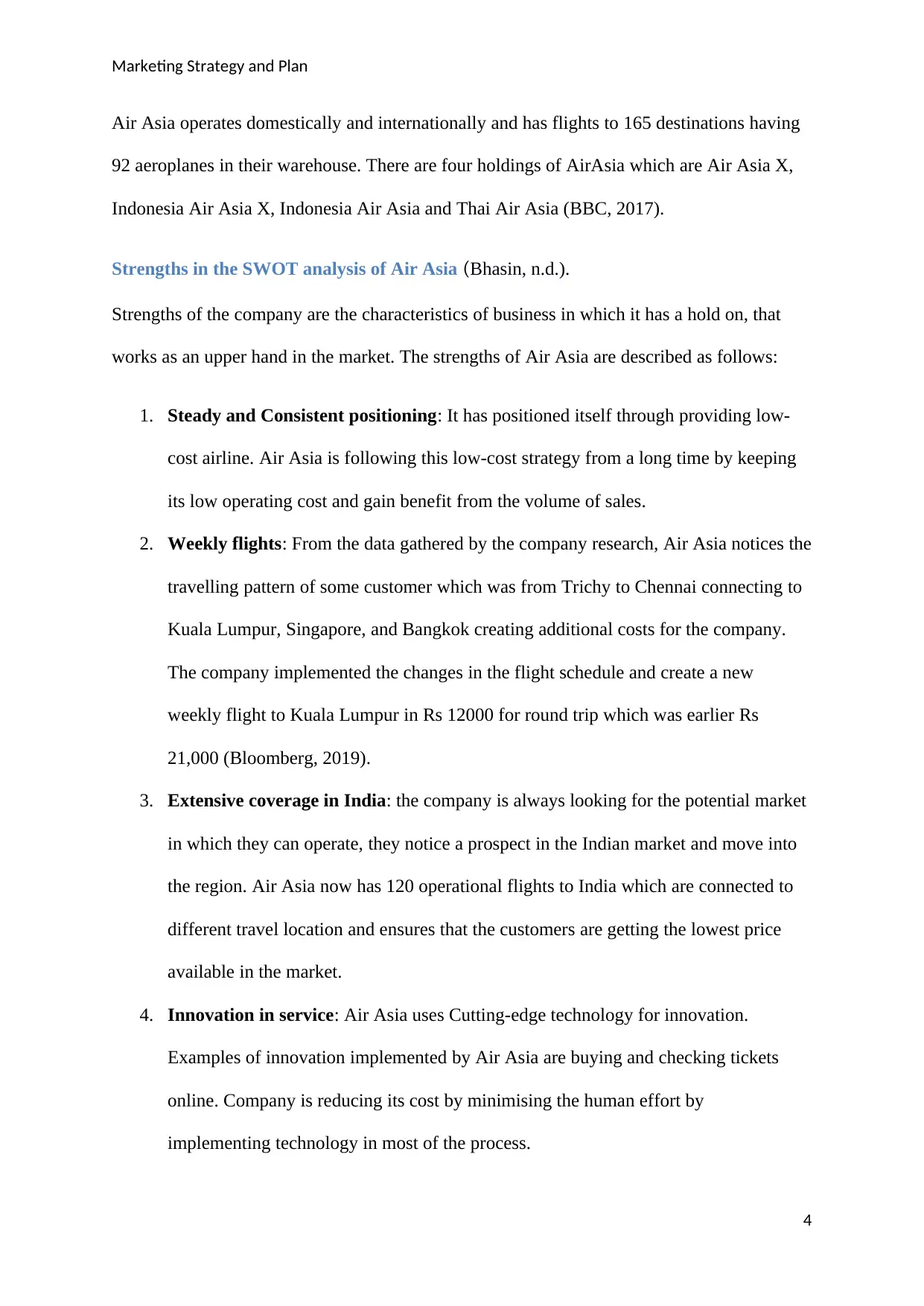
Marketing Strategy and Plan
Air Asia operates domestically and internationally and has flights to 165 destinations having
92 aeroplanes in their warehouse. There are four holdings of AirAsia which are Air Asia X,
Indonesia Air Asia X, Indonesia Air Asia and Thai Air Asia (BBC, 2017).
Strengths in the SWOT analysis of Air Asia (Bhasin, n.d.).
Strengths of the company are the characteristics of business in which it has a hold on, that
works as an upper hand in the market. The strengths of Air Asia are described as follows:
1. Steady and Consistent positioning: It has positioned itself through providing low-
cost airline. Air Asia is following this low-cost strategy from a long time by keeping
its low operating cost and gain benefit from the volume of sales.
2. Weekly flights: From the data gathered by the company research, Air Asia notices the
travelling pattern of some customer which was from Trichy to Chennai connecting to
Kuala Lumpur, Singapore, and Bangkok creating additional costs for the company.
The company implemented the changes in the flight schedule and create a new
weekly flight to Kuala Lumpur in Rs 12000 for round trip which was earlier Rs
21,000 (Bloomberg, 2019).
3. Extensive coverage in India: the company is always looking for the potential market
in which they can operate, they notice a prospect in the Indian market and move into
the region. Air Asia now has 120 operational flights to India which are connected to
different travel location and ensures that the customers are getting the lowest price
available in the market.
4. Innovation in service: Air Asia uses Cutting-edge technology for innovation.
Examples of innovation implemented by Air Asia are buying and checking tickets
online. Company is reducing its cost by minimising the human effort by
implementing technology in most of the process.
4
Air Asia operates domestically and internationally and has flights to 165 destinations having
92 aeroplanes in their warehouse. There are four holdings of AirAsia which are Air Asia X,
Indonesia Air Asia X, Indonesia Air Asia and Thai Air Asia (BBC, 2017).
Strengths in the SWOT analysis of Air Asia (Bhasin, n.d.).
Strengths of the company are the characteristics of business in which it has a hold on, that
works as an upper hand in the market. The strengths of Air Asia are described as follows:
1. Steady and Consistent positioning: It has positioned itself through providing low-
cost airline. Air Asia is following this low-cost strategy from a long time by keeping
its low operating cost and gain benefit from the volume of sales.
2. Weekly flights: From the data gathered by the company research, Air Asia notices the
travelling pattern of some customer which was from Trichy to Chennai connecting to
Kuala Lumpur, Singapore, and Bangkok creating additional costs for the company.
The company implemented the changes in the flight schedule and create a new
weekly flight to Kuala Lumpur in Rs 12000 for round trip which was earlier Rs
21,000 (Bloomberg, 2019).
3. Extensive coverage in India: the company is always looking for the potential market
in which they can operate, they notice a prospect in the Indian market and move into
the region. Air Asia now has 120 operational flights to India which are connected to
different travel location and ensures that the customers are getting the lowest price
available in the market.
4. Innovation in service: Air Asia uses Cutting-edge technology for innovation.
Examples of innovation implemented by Air Asia are buying and checking tickets
online. Company is reducing its cost by minimising the human effort by
implementing technology in most of the process.
4

Marketing Strategy and Plan
5. Successful cost-cutting: Air Asia to remain low-cost airline has taken various
measures to cut down the cost of the company. The airline has implemented the
strategy by using technology customer do most of the work.
Weaknesses of Air Asia (Bhasin, n.d.).
Weaknesses indicate the section or part in which company need to focus to apply strategy in
the weak section. Some of the key weaknesses of are:
1. Sustaining costs: As it provides low cost flights to the consumer, it faces many
challenges while do the same, as on daily basis the prices of fuel are increasing and
government increases service tax, company has to find an alternate in every
fluctuations to provide low cost flights. This is one of the major challenging aspects
for the company.
2. Low Profits: Air Asia to sustain in market at a low-cost carrier faces many issues and
is totally rely on the volumes of sales for their profit, which have resulted in low
revenues and profit of the company.
3. Challenges in balancing service quality with pricing: Air Asia unique selling
proposition is their low cost flights, even though the customer wants no compromise
on the quality basis on the low fares. The satisfaction of customer is based on the
service provided by the company, this situation is challenging for Air Asia as they
have to balance quality with price.
Opportunities in the SWOT analysis of Air Asia (Bhasin, n.d.).
Opportunities are the potential aspects available for growing and improving business. The
opportunity available for Air Asia is described in the text given below:
5
5. Successful cost-cutting: Air Asia to remain low-cost airline has taken various
measures to cut down the cost of the company. The airline has implemented the
strategy by using technology customer do most of the work.
Weaknesses of Air Asia (Bhasin, n.d.).
Weaknesses indicate the section or part in which company need to focus to apply strategy in
the weak section. Some of the key weaknesses of are:
1. Sustaining costs: As it provides low cost flights to the consumer, it faces many
challenges while do the same, as on daily basis the prices of fuel are increasing and
government increases service tax, company has to find an alternate in every
fluctuations to provide low cost flights. This is one of the major challenging aspects
for the company.
2. Low Profits: Air Asia to sustain in market at a low-cost carrier faces many issues and
is totally rely on the volumes of sales for their profit, which have resulted in low
revenues and profit of the company.
3. Challenges in balancing service quality with pricing: Air Asia unique selling
proposition is their low cost flights, even though the customer wants no compromise
on the quality basis on the low fares. The satisfaction of customer is based on the
service provided by the company, this situation is challenging for Air Asia as they
have to balance quality with price.
Opportunities in the SWOT analysis of Air Asia (Bhasin, n.d.).
Opportunities are the potential aspects available for growing and improving business. The
opportunity available for Air Asia is described in the text given below:
5
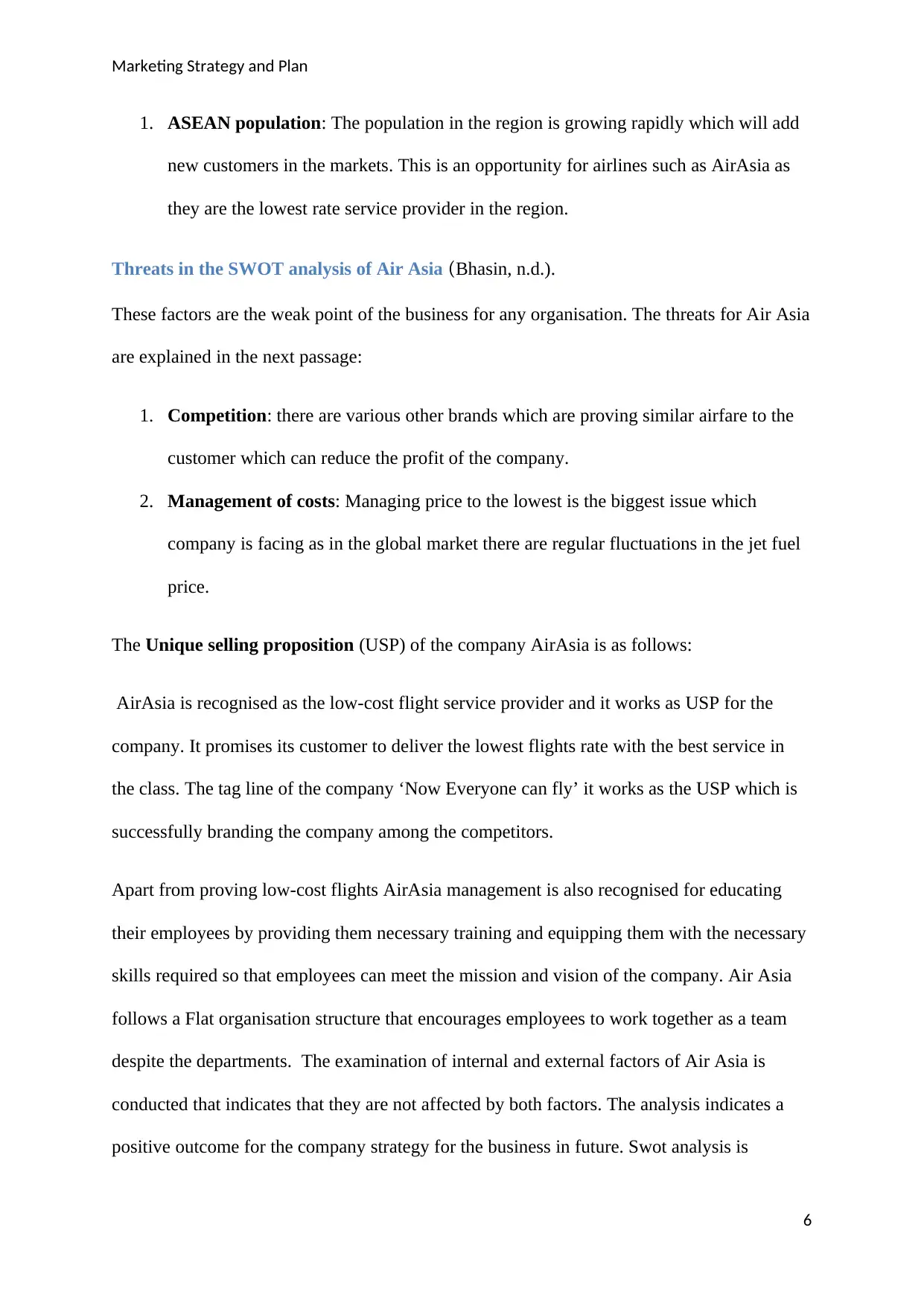
Marketing Strategy and Plan
1. ASEAN population: The population in the region is growing rapidly which will add
new customers in the markets. This is an opportunity for airlines such as AirAsia as
they are the lowest rate service provider in the region.
Threats in the SWOT analysis of Air Asia (Bhasin, n.d.).
These factors are the weak point of the business for any organisation. The threats for Air Asia
are explained in the next passage:
1. Competition: there are various other brands which are proving similar airfare to the
customer which can reduce the profit of the company.
2. Management of costs: Managing price to the lowest is the biggest issue which
company is facing as in the global market there are regular fluctuations in the jet fuel
price.
The Unique selling proposition (USP) of the company AirAsia is as follows:
AirAsia is recognised as the low-cost flight service provider and it works as USP for the
company. It promises its customer to deliver the lowest flights rate with the best service in
the class. The tag line of the company ‘Now Everyone can fly’ it works as the USP which is
successfully branding the company among the competitors.
Apart from proving low-cost flights AirAsia management is also recognised for educating
their employees by providing them necessary training and equipping them with the necessary
skills required so that employees can meet the mission and vision of the company. Air Asia
follows a Flat organisation structure that encourages employees to work together as a team
despite the departments. The examination of internal and external factors of Air Asia is
conducted that indicates that they are not affected by both factors. The analysis indicates a
positive outcome for the company strategy for the business in future. Swot analysis is
6
1. ASEAN population: The population in the region is growing rapidly which will add
new customers in the markets. This is an opportunity for airlines such as AirAsia as
they are the lowest rate service provider in the region.
Threats in the SWOT analysis of Air Asia (Bhasin, n.d.).
These factors are the weak point of the business for any organisation. The threats for Air Asia
are explained in the next passage:
1. Competition: there are various other brands which are proving similar airfare to the
customer which can reduce the profit of the company.
2. Management of costs: Managing price to the lowest is the biggest issue which
company is facing as in the global market there are regular fluctuations in the jet fuel
price.
The Unique selling proposition (USP) of the company AirAsia is as follows:
AirAsia is recognised as the low-cost flight service provider and it works as USP for the
company. It promises its customer to deliver the lowest flights rate with the best service in
the class. The tag line of the company ‘Now Everyone can fly’ it works as the USP which is
successfully branding the company among the competitors.
Apart from proving low-cost flights AirAsia management is also recognised for educating
their employees by providing them necessary training and equipping them with the necessary
skills required so that employees can meet the mission and vision of the company. Air Asia
follows a Flat organisation structure that encourages employees to work together as a team
despite the departments. The examination of internal and external factors of Air Asia is
conducted that indicates that they are not affected by both factors. The analysis indicates a
positive outcome for the company strategy for the business in future. Swot analysis is
6
Paraphrase This Document
Need a fresh take? Get an instant paraphrase of this document with our AI Paraphraser

Marketing Strategy and Plan
conducted to get to the deep insight of the company situation to develop new methods to
maximise their profit of the company. Few strategies are suggested for AirAsia which can be
linked to the company’s operations.
Using PESTEL and Porter’s Five Forces model analysis of external factors is conducted.
MACRO-ENVIRONMENTAL ANALYSIS
PESTEL
a) Political Factors: Governing authority policy are important for the growth and
development of aviation industry, as the policy restricts or broadens the migration policy
which increases or decreases the number of tourists (Yashodha, 2012). Thailand
administration has implemented various policy and facility which people can get so as to
boost tourism such as waiving temporary visa fees (AirAsia, 2016). On the other hand, the
Malaysian government has implied various taxes on domestic and international flights, this
impacted largely as the number of service providers was reduced (Matta, 2016).
b) Economical Factors: Fluctuation Various economic fluctuations has its impact on
business as in case of Air Asia they are deemed to provide LCCs to the customer whether the
fuel prices increases or decrease, in order to main the LCCs it in reduces the other costs to a
level so that they can maintain a reserve portion for the fuel price (Merkert, 2015). The
expansion of the aviation industry is directly linked with the expansion of GDP of the
country. For example, GDP and aviation industry are directly related to each other as it is
noticed that if Aviation industry is running in profits, the GDP will also boom and vice-versa
(Centre for Aviation, 2016). When there is a decline in the regional currency as compared to
US dollar in the past few years, it has increased the flow of tourist to ASEAN countries
which earlier used to choose European countries (AirAsia, 2016).
7
conducted to get to the deep insight of the company situation to develop new methods to
maximise their profit of the company. Few strategies are suggested for AirAsia which can be
linked to the company’s operations.
Using PESTEL and Porter’s Five Forces model analysis of external factors is conducted.
MACRO-ENVIRONMENTAL ANALYSIS
PESTEL
a) Political Factors: Governing authority policy are important for the growth and
development of aviation industry, as the policy restricts or broadens the migration policy
which increases or decreases the number of tourists (Yashodha, 2012). Thailand
administration has implemented various policy and facility which people can get so as to
boost tourism such as waiving temporary visa fees (AirAsia, 2016). On the other hand, the
Malaysian government has implied various taxes on domestic and international flights, this
impacted largely as the number of service providers was reduced (Matta, 2016).
b) Economical Factors: Fluctuation Various economic fluctuations has its impact on
business as in case of Air Asia they are deemed to provide LCCs to the customer whether the
fuel prices increases or decrease, in order to main the LCCs it in reduces the other costs to a
level so that they can maintain a reserve portion for the fuel price (Merkert, 2015). The
expansion of the aviation industry is directly linked with the expansion of GDP of the
country. For example, GDP and aviation industry are directly related to each other as it is
noticed that if Aviation industry is running in profits, the GDP will also boom and vice-versa
(Centre for Aviation, 2016). When there is a decline in the regional currency as compared to
US dollar in the past few years, it has increased the flow of tourist to ASEAN countries
which earlier used to choose European countries (AirAsia, 2016).
7

Marketing Strategy and Plan
c) Social-Cultural Factor: In ASEAN region nearly 50% of world lives which is a huge
potential for the company operating in this region. The perception people have about the low
cost carrier is the same as they think they such service provider will lack some safety
standard (Welford, 2010). To tap into the potential market, the companies have to build
customer trust and satisfaction. As in the aviation industry, it is noticed that the major
revenue is gained from the returning customers which is nearly about 50% of the revenue
(Welford, 2010). Due to the culture of family bonding in the ASEAN regions, the family
frequently uses flights more frequent (AirAsia Berhad, Annual Report 2009).
d) Technological Factor: Technology reduces human effort helps an organisation to reduce
its workforce and the technology helps in check in and checks out process which saves the
additional cost bearded by the company and develops additional income (AirAsia Berhad,
Annual Report, 2009). It also benefits indirectly as technology helps in avoiding the spread of
various disease that can be transmitted by airlines, various new technology are developed and
implemented to reduce such things (United States GAO, 2015). Apart from airports
technology can also be adopted in the aeroplanes the new model Airbus 320 aircraft which
has ‘sharklet wing tips’ that helps in reducing wind drag and increase the fuel efficiency
(Vazquez, 2015).
e) Environmental/Ecological Factors: The “No Frills Service” method is used by airports
and airlines mutually the motive is to reduce unnecessary cost occurring (Yashodha, 2012).
The Aviation industry has taken various steps to reduce energy consumption. By monitoring
carbon footprint, air contaminations are reduced (Airasia Annual Report, 2016). Natural
disasters also affect the aviation industry as during that particular period various viral
infections are spread across the nation (AirAsia Annual Report 2015).
8
c) Social-Cultural Factor: In ASEAN region nearly 50% of world lives which is a huge
potential for the company operating in this region. The perception people have about the low
cost carrier is the same as they think they such service provider will lack some safety
standard (Welford, 2010). To tap into the potential market, the companies have to build
customer trust and satisfaction. As in the aviation industry, it is noticed that the major
revenue is gained from the returning customers which is nearly about 50% of the revenue
(Welford, 2010). Due to the culture of family bonding in the ASEAN regions, the family
frequently uses flights more frequent (AirAsia Berhad, Annual Report 2009).
d) Technological Factor: Technology reduces human effort helps an organisation to reduce
its workforce and the technology helps in check in and checks out process which saves the
additional cost bearded by the company and develops additional income (AirAsia Berhad,
Annual Report, 2009). It also benefits indirectly as technology helps in avoiding the spread of
various disease that can be transmitted by airlines, various new technology are developed and
implemented to reduce such things (United States GAO, 2015). Apart from airports
technology can also be adopted in the aeroplanes the new model Airbus 320 aircraft which
has ‘sharklet wing tips’ that helps in reducing wind drag and increase the fuel efficiency
(Vazquez, 2015).
e) Environmental/Ecological Factors: The “No Frills Service” method is used by airports
and airlines mutually the motive is to reduce unnecessary cost occurring (Yashodha, 2012).
The Aviation industry has taken various steps to reduce energy consumption. By monitoring
carbon footprint, air contaminations are reduced (Airasia Annual Report, 2016). Natural
disasters also affect the aviation industry as during that particular period various viral
infections are spread across the nation (AirAsia Annual Report 2015).
8
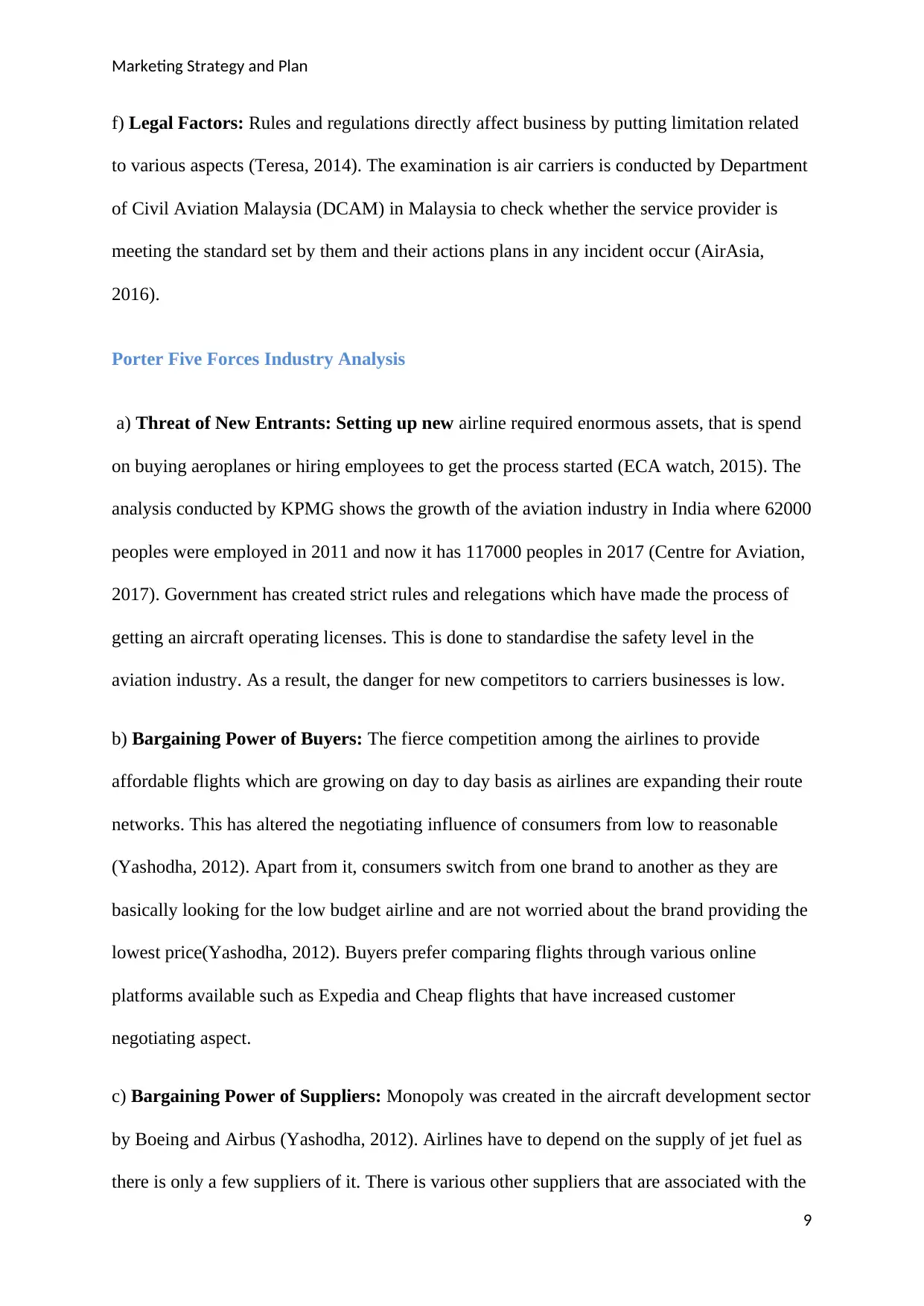
Marketing Strategy and Plan
f) Legal Factors: Rules and regulations directly affect business by putting limitation related
to various aspects (Teresa, 2014). The examination is air carriers is conducted by Department
of Civil Aviation Malaysia (DCAM) in Malaysia to check whether the service provider is
meeting the standard set by them and their actions plans in any incident occur (AirAsia,
2016).
Porter Five Forces Industry Analysis
a) Threat of New Entrants: Setting up new airline required enormous assets, that is spend
on buying aeroplanes or hiring employees to get the process started (ECA watch, 2015). The
analysis conducted by KPMG shows the growth of the aviation industry in India where 62000
peoples were employed in 2011 and now it has 117000 peoples in 2017 (Centre for Aviation,
2017). Government has created strict rules and relegations which have made the process of
getting an aircraft operating licenses. This is done to standardise the safety level in the
aviation industry. As a result, the danger for new competitors to carriers businesses is low.
b) Bargaining Power of Buyers: The fierce competition among the airlines to provide
affordable flights which are growing on day to day basis as airlines are expanding their route
networks. This has altered the negotiating influence of consumers from low to reasonable
(Yashodha, 2012). Apart from it, consumers switch from one brand to another as they are
basically looking for the low budget airline and are not worried about the brand providing the
lowest price(Yashodha, 2012). Buyers prefer comparing flights through various online
platforms available such as Expedia and Cheap flights that have increased customer
negotiating aspect.
c) Bargaining Power of Suppliers: Monopoly was created in the aircraft development sector
by Boeing and Airbus (Yashodha, 2012). Airlines have to depend on the supply of jet fuel as
there is only a few suppliers of it. There is various other suppliers that are associated with the
9
f) Legal Factors: Rules and regulations directly affect business by putting limitation related
to various aspects (Teresa, 2014). The examination is air carriers is conducted by Department
of Civil Aviation Malaysia (DCAM) in Malaysia to check whether the service provider is
meeting the standard set by them and their actions plans in any incident occur (AirAsia,
2016).
Porter Five Forces Industry Analysis
a) Threat of New Entrants: Setting up new airline required enormous assets, that is spend
on buying aeroplanes or hiring employees to get the process started (ECA watch, 2015). The
analysis conducted by KPMG shows the growth of the aviation industry in India where 62000
peoples were employed in 2011 and now it has 117000 peoples in 2017 (Centre for Aviation,
2017). Government has created strict rules and relegations which have made the process of
getting an aircraft operating licenses. This is done to standardise the safety level in the
aviation industry. As a result, the danger for new competitors to carriers businesses is low.
b) Bargaining Power of Buyers: The fierce competition among the airlines to provide
affordable flights which are growing on day to day basis as airlines are expanding their route
networks. This has altered the negotiating influence of consumers from low to reasonable
(Yashodha, 2012). Apart from it, consumers switch from one brand to another as they are
basically looking for the low budget airline and are not worried about the brand providing the
lowest price(Yashodha, 2012). Buyers prefer comparing flights through various online
platforms available such as Expedia and Cheap flights that have increased customer
negotiating aspect.
c) Bargaining Power of Suppliers: Monopoly was created in the aircraft development sector
by Boeing and Airbus (Yashodha, 2012). Airlines have to depend on the supply of jet fuel as
there is only a few suppliers of it. There is various other suppliers that are associated with the
9
Secure Best Marks with AI Grader
Need help grading? Try our AI Grader for instant feedback on your assignments.
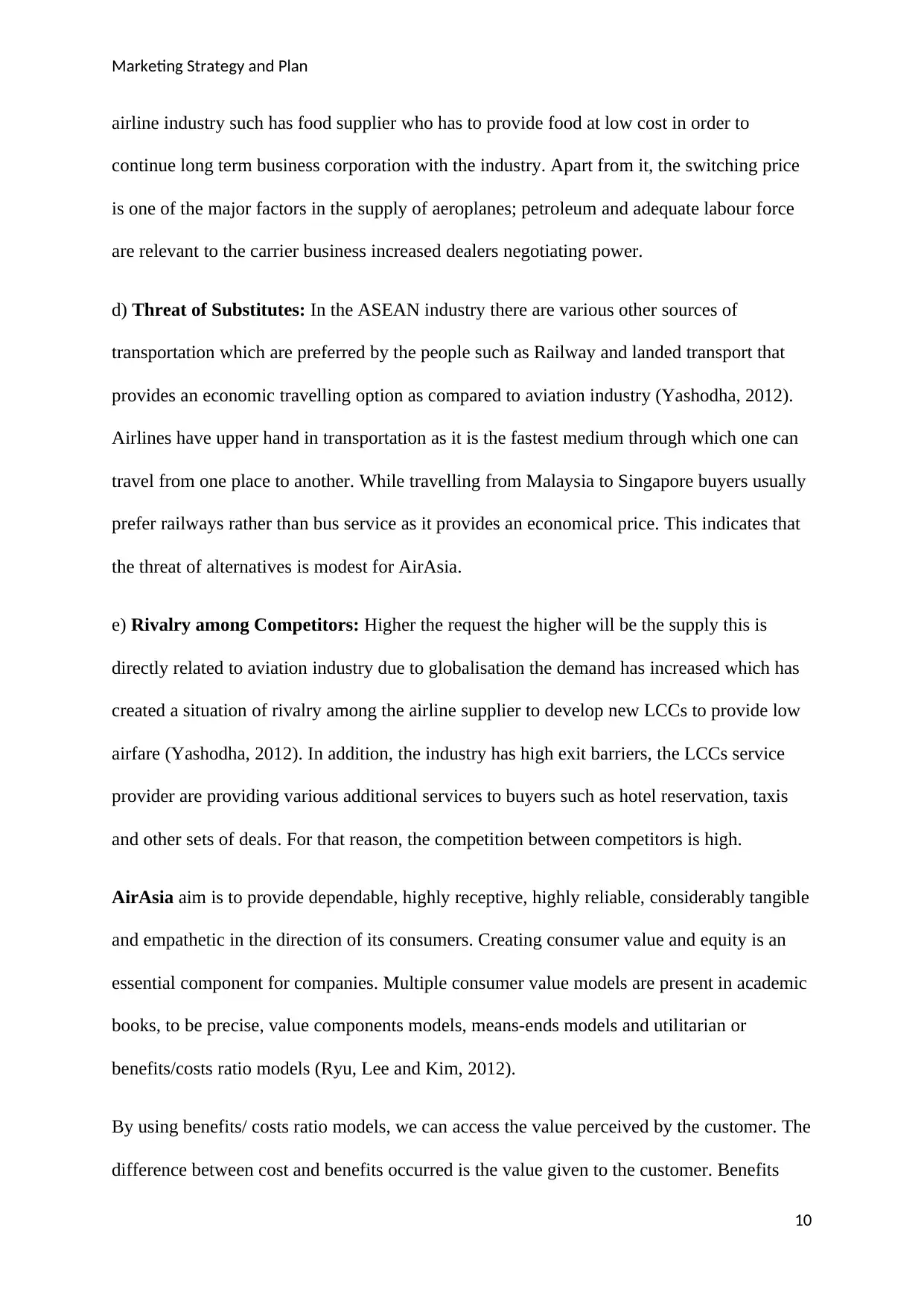
Marketing Strategy and Plan
airline industry such has food supplier who has to provide food at low cost in order to
continue long term business corporation with the industry. Apart from it, the switching price
is one of the major factors in the supply of aeroplanes; petroleum and adequate labour force
are relevant to the carrier business increased dealers negotiating power.
d) Threat of Substitutes: In the ASEAN industry there are various other sources of
transportation which are preferred by the people such as Railway and landed transport that
provides an economic travelling option as compared to aviation industry (Yashodha, 2012).
Airlines have upper hand in transportation as it is the fastest medium through which one can
travel from one place to another. While travelling from Malaysia to Singapore buyers usually
prefer railways rather than bus service as it provides an economical price. This indicates that
the threat of alternatives is modest for AirAsia.
e) Rivalry among Competitors: Higher the request the higher will be the supply this is
directly related to aviation industry due to globalisation the demand has increased which has
created a situation of rivalry among the airline supplier to develop new LCCs to provide low
airfare (Yashodha, 2012). In addition, the industry has high exit barriers, the LCCs service
provider are providing various additional services to buyers such as hotel reservation, taxis
and other sets of deals. For that reason, the competition between competitors is high.
AirAsia aim is to provide dependable, highly receptive, highly reliable, considerably tangible
and empathetic in the direction of its consumers. Creating consumer value and equity is an
essential component for companies. Multiple consumer value models are present in academic
books, to be precise, value components models, means-ends models and utilitarian or
benefits/costs ratio models (Ryu, Lee and Kim, 2012).
By using benefits/ costs ratio models, we can access the value perceived by the customer. The
difference between cost and benefits occurred is the value given to the customer. Benefits
10
airline industry such has food supplier who has to provide food at low cost in order to
continue long term business corporation with the industry. Apart from it, the switching price
is one of the major factors in the supply of aeroplanes; petroleum and adequate labour force
are relevant to the carrier business increased dealers negotiating power.
d) Threat of Substitutes: In the ASEAN industry there are various other sources of
transportation which are preferred by the people such as Railway and landed transport that
provides an economic travelling option as compared to aviation industry (Yashodha, 2012).
Airlines have upper hand in transportation as it is the fastest medium through which one can
travel from one place to another. While travelling from Malaysia to Singapore buyers usually
prefer railways rather than bus service as it provides an economical price. This indicates that
the threat of alternatives is modest for AirAsia.
e) Rivalry among Competitors: Higher the request the higher will be the supply this is
directly related to aviation industry due to globalisation the demand has increased which has
created a situation of rivalry among the airline supplier to develop new LCCs to provide low
airfare (Yashodha, 2012). In addition, the industry has high exit barriers, the LCCs service
provider are providing various additional services to buyers such as hotel reservation, taxis
and other sets of deals. For that reason, the competition between competitors is high.
AirAsia aim is to provide dependable, highly receptive, highly reliable, considerably tangible
and empathetic in the direction of its consumers. Creating consumer value and equity is an
essential component for companies. Multiple consumer value models are present in academic
books, to be precise, value components models, means-ends models and utilitarian or
benefits/costs ratio models (Ryu, Lee and Kim, 2012).
By using benefits/ costs ratio models, we can access the value perceived by the customer. The
difference between cost and benefits occurred is the value given to the customer. Benefits
10
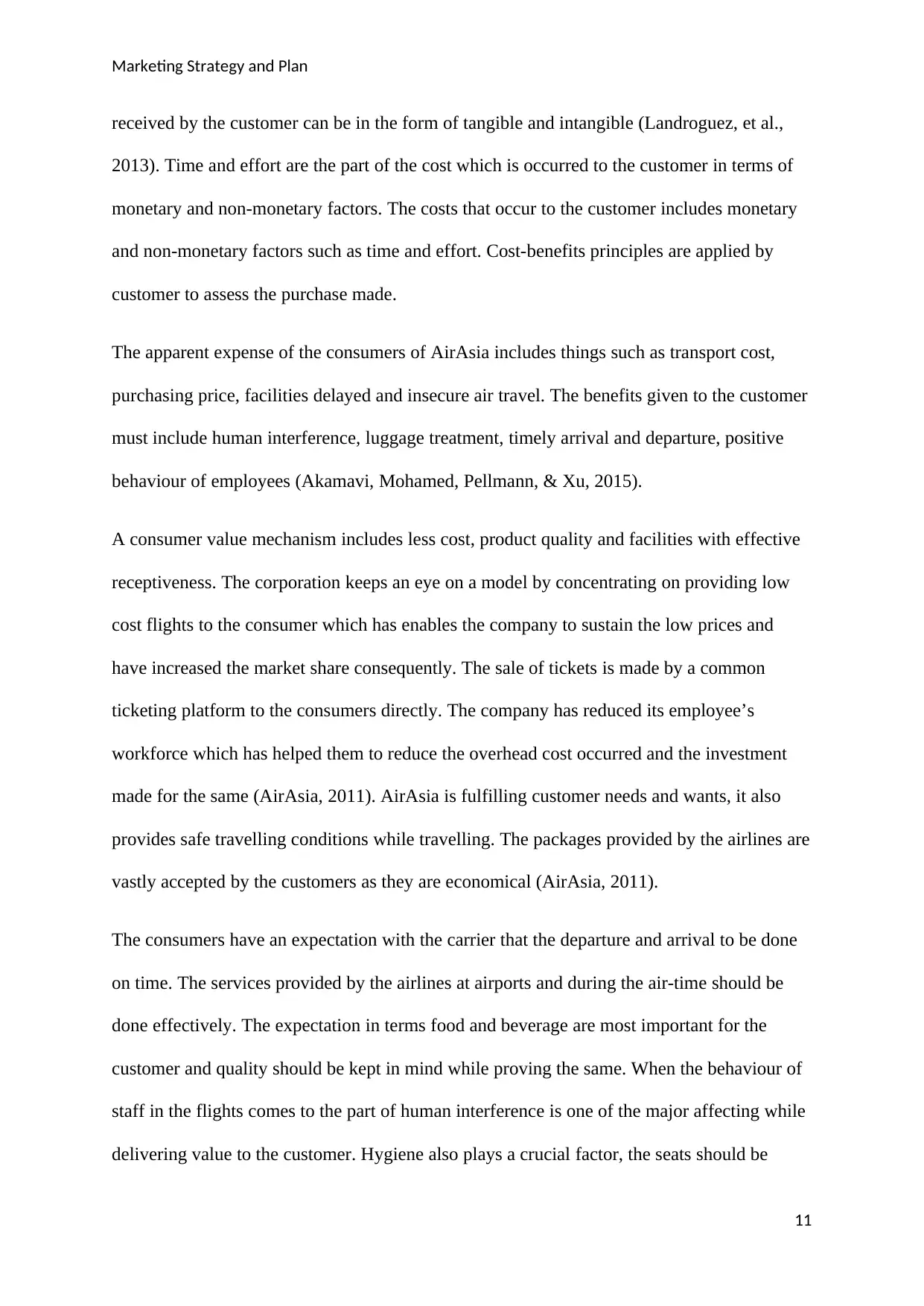
Marketing Strategy and Plan
received by the customer can be in the form of tangible and intangible (Landroguez, et al.,
2013). Time and effort are the part of the cost which is occurred to the customer in terms of
monetary and non-monetary factors. The costs that occur to the customer includes monetary
and non-monetary factors such as time and effort. Cost-benefits principles are applied by
customer to assess the purchase made.
The apparent expense of the consumers of AirAsia includes things such as transport cost,
purchasing price, facilities delayed and insecure air travel. The benefits given to the customer
must include human interference, luggage treatment, timely arrival and departure, positive
behaviour of employees (Akamavi, Mohamed, Pellmann, & Xu, 2015).
A consumer value mechanism includes less cost, product quality and facilities with effective
receptiveness. The corporation keeps an eye on a model by concentrating on providing low
cost flights to the consumer which has enables the company to sustain the low prices and
have increased the market share consequently. The sale of tickets is made by a common
ticketing platform to the consumers directly. The company has reduced its employee’s
workforce which has helped them to reduce the overhead cost occurred and the investment
made for the same (AirAsia, 2011). AirAsia is fulfilling customer needs and wants, it also
provides safe travelling conditions while travelling. The packages provided by the airlines are
vastly accepted by the customers as they are economical (AirAsia, 2011).
The consumers have an expectation with the carrier that the departure and arrival to be done
on time. The services provided by the airlines at airports and during the air-time should be
done effectively. The expectation in terms food and beverage are most important for the
customer and quality should be kept in mind while proving the same. When the behaviour of
staff in the flights comes to the part of human interference is one of the major affecting while
delivering value to the customer. Hygiene also plays a crucial factor, the seats should be
11
received by the customer can be in the form of tangible and intangible (Landroguez, et al.,
2013). Time and effort are the part of the cost which is occurred to the customer in terms of
monetary and non-monetary factors. The costs that occur to the customer includes monetary
and non-monetary factors such as time and effort. Cost-benefits principles are applied by
customer to assess the purchase made.
The apparent expense of the consumers of AirAsia includes things such as transport cost,
purchasing price, facilities delayed and insecure air travel. The benefits given to the customer
must include human interference, luggage treatment, timely arrival and departure, positive
behaviour of employees (Akamavi, Mohamed, Pellmann, & Xu, 2015).
A consumer value mechanism includes less cost, product quality and facilities with effective
receptiveness. The corporation keeps an eye on a model by concentrating on providing low
cost flights to the consumer which has enables the company to sustain the low prices and
have increased the market share consequently. The sale of tickets is made by a common
ticketing platform to the consumers directly. The company has reduced its employee’s
workforce which has helped them to reduce the overhead cost occurred and the investment
made for the same (AirAsia, 2011). AirAsia is fulfilling customer needs and wants, it also
provides safe travelling conditions while travelling. The packages provided by the airlines are
vastly accepted by the customers as they are economical (AirAsia, 2011).
The consumers have an expectation with the carrier that the departure and arrival to be done
on time. The services provided by the airlines at airports and during the air-time should be
done effectively. The expectation in terms food and beverage are most important for the
customer and quality should be kept in mind while proving the same. When the behaviour of
staff in the flights comes to the part of human interference is one of the major affecting while
delivering value to the customer. Hygiene also plays a crucial factor, the seats should be
11
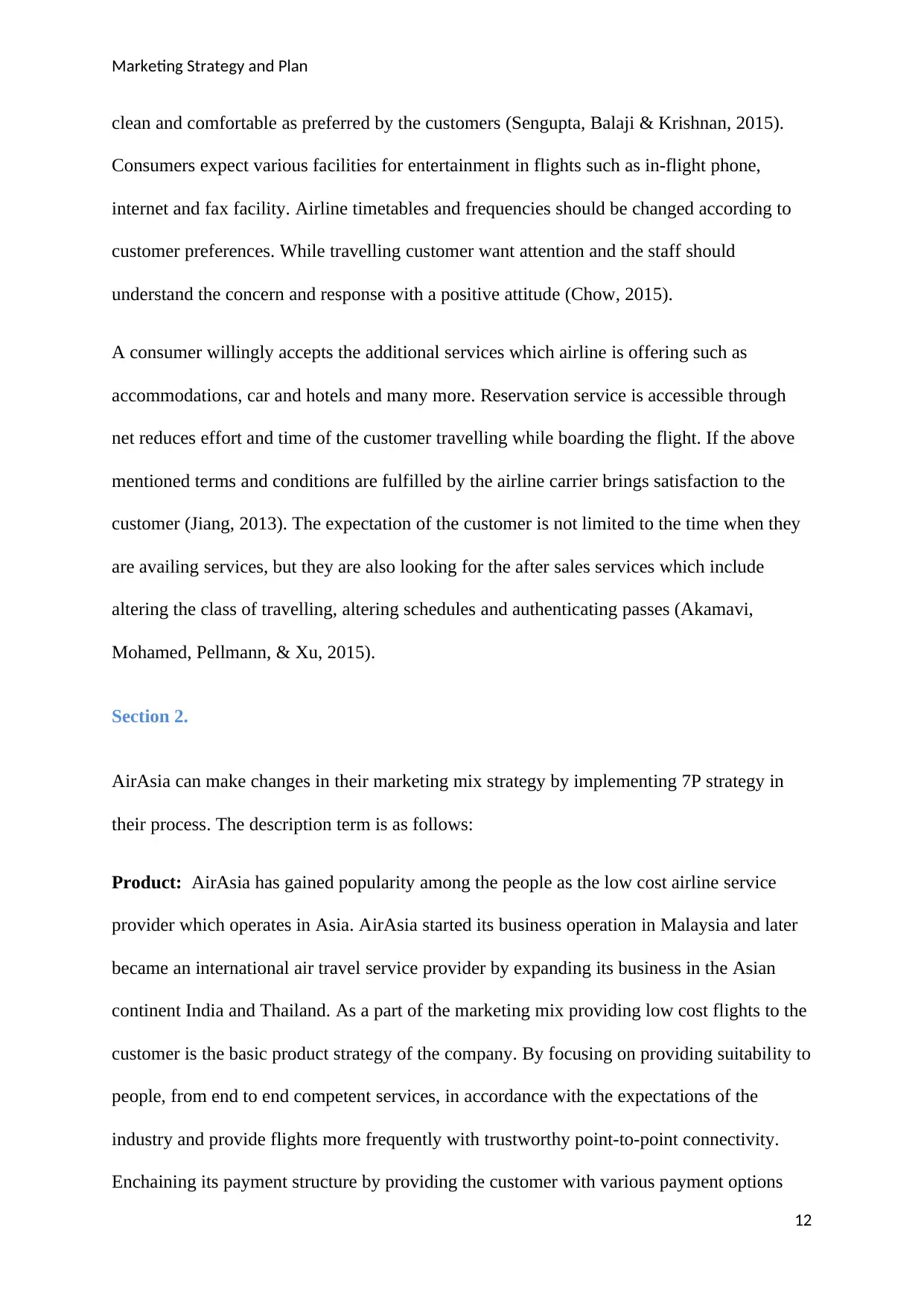
Marketing Strategy and Plan
clean and comfortable as preferred by the customers (Sengupta, Balaji & Krishnan, 2015).
Consumers expect various facilities for entertainment in flights such as in-flight phone,
internet and fax facility. Airline timetables and frequencies should be changed according to
customer preferences. While travelling customer want attention and the staff should
understand the concern and response with a positive attitude (Chow, 2015).
A consumer willingly accepts the additional services which airline is offering such as
accommodations, car and hotels and many more. Reservation service is accessible through
net reduces effort and time of the customer travelling while boarding the flight. If the above
mentioned terms and conditions are fulfilled by the airline carrier brings satisfaction to the
customer (Jiang, 2013). The expectation of the customer is not limited to the time when they
are availing services, but they are also looking for the after sales services which include
altering the class of travelling, altering schedules and authenticating passes (Akamavi,
Mohamed, Pellmann, & Xu, 2015).
Section 2.
AirAsia can make changes in their marketing mix strategy by implementing 7P strategy in
their process. The description term is as follows:
Product: AirAsia has gained popularity among the people as the low cost airline service
provider which operates in Asia. AirAsia started its business operation in Malaysia and later
became an international air travel service provider by expanding its business in the Asian
continent India and Thailand. As a part of the marketing mix providing low cost flights to the
customer is the basic product strategy of the company. By focusing on providing suitability to
people, from end to end competent services, in accordance with the expectations of the
industry and provide flights more frequently with trustworthy point-to-point connectivity.
Enchaining its payment structure by providing the customer with various payment options
12
clean and comfortable as preferred by the customers (Sengupta, Balaji & Krishnan, 2015).
Consumers expect various facilities for entertainment in flights such as in-flight phone,
internet and fax facility. Airline timetables and frequencies should be changed according to
customer preferences. While travelling customer want attention and the staff should
understand the concern and response with a positive attitude (Chow, 2015).
A consumer willingly accepts the additional services which airline is offering such as
accommodations, car and hotels and many more. Reservation service is accessible through
net reduces effort and time of the customer travelling while boarding the flight. If the above
mentioned terms and conditions are fulfilled by the airline carrier brings satisfaction to the
customer (Jiang, 2013). The expectation of the customer is not limited to the time when they
are availing services, but they are also looking for the after sales services which include
altering the class of travelling, altering schedules and authenticating passes (Akamavi,
Mohamed, Pellmann, & Xu, 2015).
Section 2.
AirAsia can make changes in their marketing mix strategy by implementing 7P strategy in
their process. The description term is as follows:
Product: AirAsia has gained popularity among the people as the low cost airline service
provider which operates in Asia. AirAsia started its business operation in Malaysia and later
became an international air travel service provider by expanding its business in the Asian
continent India and Thailand. As a part of the marketing mix providing low cost flights to the
customer is the basic product strategy of the company. By focusing on providing suitability to
people, from end to end competent services, in accordance with the expectations of the
industry and provide flights more frequently with trustworthy point-to-point connectivity.
Enchaining its payment structure by providing the customer with various payment options
12
Paraphrase This Document
Need a fresh take? Get an instant paraphrase of this document with our AI Paraphraser
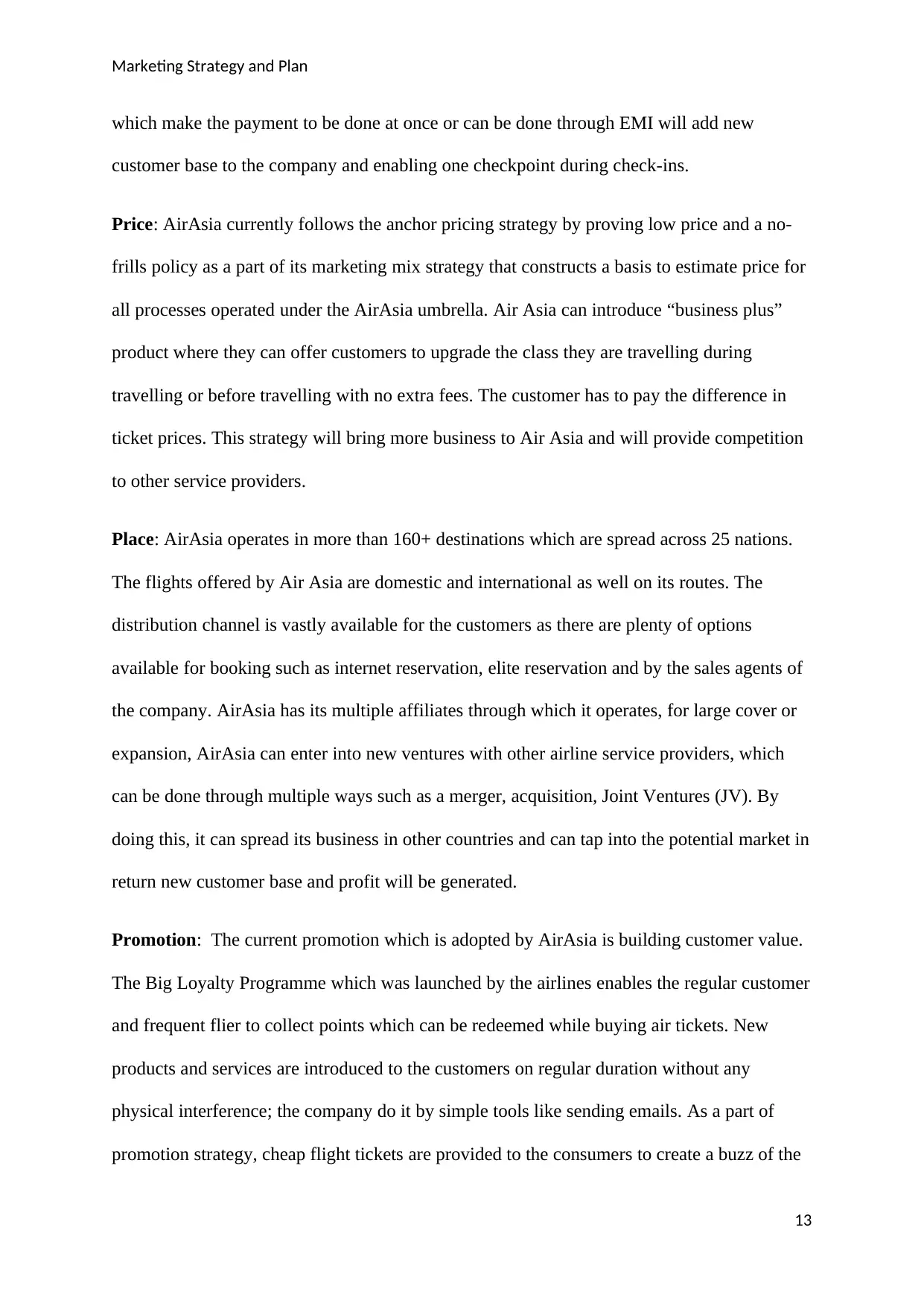
Marketing Strategy and Plan
which make the payment to be done at once or can be done through EMI will add new
customer base to the company and enabling one checkpoint during check-ins.
Price: AirAsia currently follows the anchor pricing strategy by proving low price and a no-
frills policy as a part of its marketing mix strategy that constructs a basis to estimate price for
all processes operated under the AirAsia umbrella. Air Asia can introduce “business plus”
product where they can offer customers to upgrade the class they are travelling during
travelling or before travelling with no extra fees. The customer has to pay the difference in
ticket prices. This strategy will bring more business to Air Asia and will provide competition
to other service providers.
Place: AirAsia operates in more than 160+ destinations which are spread across 25 nations.
The flights offered by Air Asia are domestic and international as well on its routes. The
distribution channel is vastly available for the customers as there are plenty of options
available for booking such as internet reservation, elite reservation and by the sales agents of
the company. AirAsia has its multiple affiliates through which it operates, for large cover or
expansion, AirAsia can enter into new ventures with other airline service providers, which
can be done through multiple ways such as a merger, acquisition, Joint Ventures (JV). By
doing this, it can spread its business in other countries and can tap into the potential market in
return new customer base and profit will be generated.
Promotion: The current promotion which is adopted by AirAsia is building customer value.
The Big Loyalty Programme which was launched by the airlines enables the regular customer
and frequent flier to collect points which can be redeemed while buying air tickets. New
products and services are introduced to the customers on regular duration without any
physical interference; the company do it by simple tools like sending emails. As a part of
promotion strategy, cheap flight tickets are provided to the consumers to create a buzz of the
13
which make the payment to be done at once or can be done through EMI will add new
customer base to the company and enabling one checkpoint during check-ins.
Price: AirAsia currently follows the anchor pricing strategy by proving low price and a no-
frills policy as a part of its marketing mix strategy that constructs a basis to estimate price for
all processes operated under the AirAsia umbrella. Air Asia can introduce “business plus”
product where they can offer customers to upgrade the class they are travelling during
travelling or before travelling with no extra fees. The customer has to pay the difference in
ticket prices. This strategy will bring more business to Air Asia and will provide competition
to other service providers.
Place: AirAsia operates in more than 160+ destinations which are spread across 25 nations.
The flights offered by Air Asia are domestic and international as well on its routes. The
distribution channel is vastly available for the customers as there are plenty of options
available for booking such as internet reservation, elite reservation and by the sales agents of
the company. AirAsia has its multiple affiliates through which it operates, for large cover or
expansion, AirAsia can enter into new ventures with other airline service providers, which
can be done through multiple ways such as a merger, acquisition, Joint Ventures (JV). By
doing this, it can spread its business in other countries and can tap into the potential market in
return new customer base and profit will be generated.
Promotion: The current promotion which is adopted by AirAsia is building customer value.
The Big Loyalty Programme which was launched by the airlines enables the regular customer
and frequent flier to collect points which can be redeemed while buying air tickets. New
products and services are introduced to the customers on regular duration without any
physical interference; the company do it by simple tools like sending emails. As a part of
promotion strategy, cheap flight tickets are provided to the consumers to create a buzz of the
13
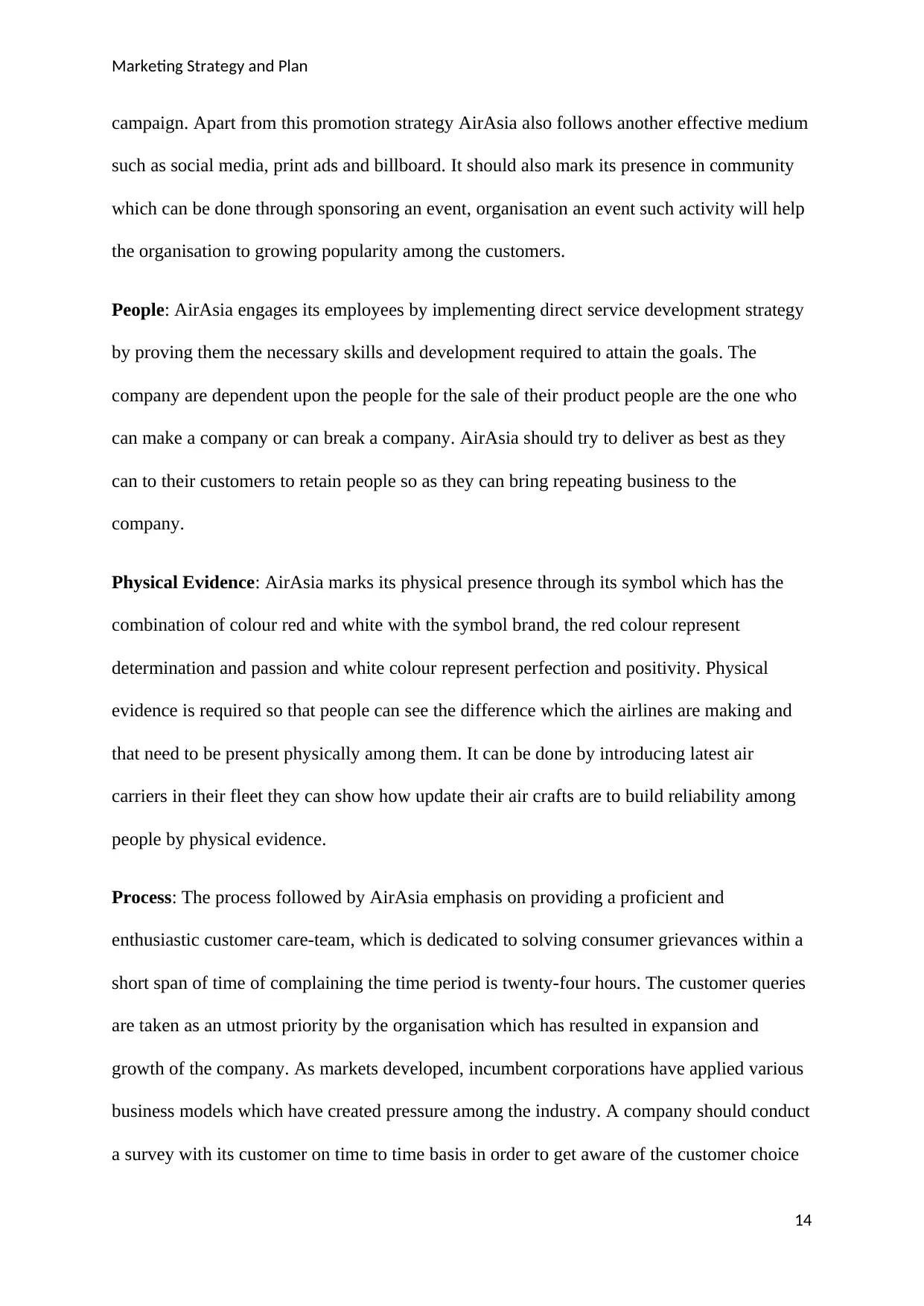
Marketing Strategy and Plan
campaign. Apart from this promotion strategy AirAsia also follows another effective medium
such as social media, print ads and billboard. It should also mark its presence in community
which can be done through sponsoring an event, organisation an event such activity will help
the organisation to growing popularity among the customers.
People: AirAsia engages its employees by implementing direct service development strategy
by proving them the necessary skills and development required to attain the goals. The
company are dependent upon the people for the sale of their product people are the one who
can make a company or can break a company. AirAsia should try to deliver as best as they
can to their customers to retain people so as they can bring repeating business to the
company.
Physical Evidence: AirAsia marks its physical presence through its symbol which has the
combination of colour red and white with the symbol brand, the red colour represent
determination and passion and white colour represent perfection and positivity. Physical
evidence is required so that people can see the difference which the airlines are making and
that need to be present physically among them. It can be done by introducing latest air
carriers in their fleet they can show how update their air crafts are to build reliability among
people by physical evidence.
Process: The process followed by AirAsia emphasis on providing a proficient and
enthusiastic customer care-team, which is dedicated to solving consumer grievances within a
short span of time of complaining the time period is twenty-four hours. The customer queries
are taken as an utmost priority by the organisation which has resulted in expansion and
growth of the company. As markets developed, incumbent corporations have applied various
business models which have created pressure among the industry. A company should conduct
a survey with its customer on time to time basis in order to get aware of the customer choice
14
campaign. Apart from this promotion strategy AirAsia also follows another effective medium
such as social media, print ads and billboard. It should also mark its presence in community
which can be done through sponsoring an event, organisation an event such activity will help
the organisation to growing popularity among the customers.
People: AirAsia engages its employees by implementing direct service development strategy
by proving them the necessary skills and development required to attain the goals. The
company are dependent upon the people for the sale of their product people are the one who
can make a company or can break a company. AirAsia should try to deliver as best as they
can to their customers to retain people so as they can bring repeating business to the
company.
Physical Evidence: AirAsia marks its physical presence through its symbol which has the
combination of colour red and white with the symbol brand, the red colour represent
determination and passion and white colour represent perfection and positivity. Physical
evidence is required so that people can see the difference which the airlines are making and
that need to be present physically among them. It can be done by introducing latest air
carriers in their fleet they can show how update their air crafts are to build reliability among
people by physical evidence.
Process: The process followed by AirAsia emphasis on providing a proficient and
enthusiastic customer care-team, which is dedicated to solving consumer grievances within a
short span of time of complaining the time period is twenty-four hours. The customer queries
are taken as an utmost priority by the organisation which has resulted in expansion and
growth of the company. As markets developed, incumbent corporations have applied various
business models which have created pressure among the industry. A company should conduct
a survey with its customer on time to time basis in order to get aware of the customer choice
14
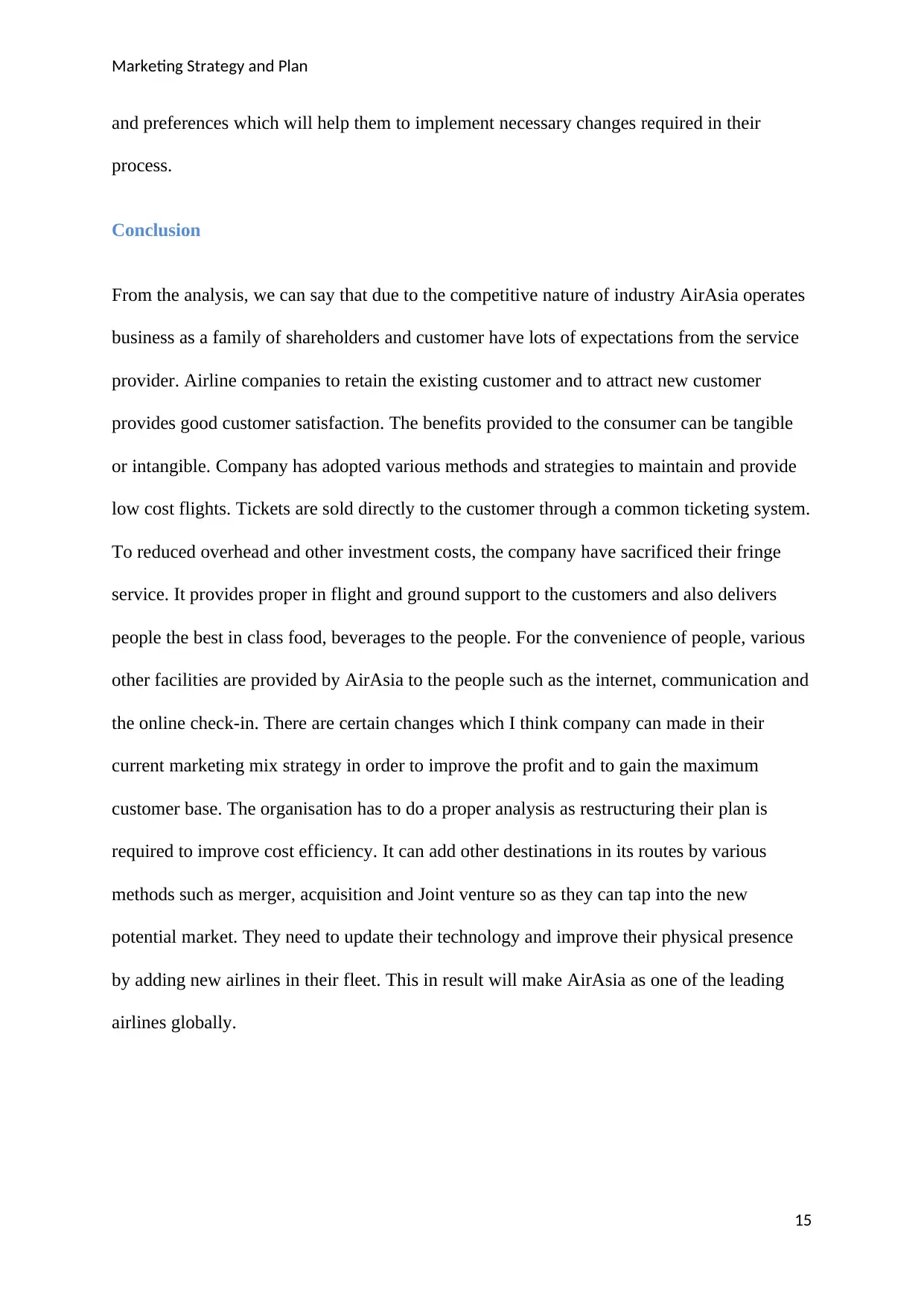
Marketing Strategy and Plan
and preferences which will help them to implement necessary changes required in their
process.
Conclusion
From the analysis, we can say that due to the competitive nature of industry AirAsia operates
business as a family of shareholders and customer have lots of expectations from the service
provider. Airline companies to retain the existing customer and to attract new customer
provides good customer satisfaction. The benefits provided to the consumer can be tangible
or intangible. Company has adopted various methods and strategies to maintain and provide
low cost flights. Tickets are sold directly to the customer through a common ticketing system.
To reduced overhead and other investment costs, the company have sacrificed their fringe
service. It provides proper in flight and ground support to the customers and also delivers
people the best in class food, beverages to the people. For the convenience of people, various
other facilities are provided by AirAsia to the people such as the internet, communication and
the online check-in. There are certain changes which I think company can made in their
current marketing mix strategy in order to improve the profit and to gain the maximum
customer base. The organisation has to do a proper analysis as restructuring their plan is
required to improve cost efficiency. It can add other destinations in its routes by various
methods such as merger, acquisition and Joint venture so as they can tap into the new
potential market. They need to update their technology and improve their physical presence
by adding new airlines in their fleet. This in result will make AirAsia as one of the leading
airlines globally.
15
and preferences which will help them to implement necessary changes required in their
process.
Conclusion
From the analysis, we can say that due to the competitive nature of industry AirAsia operates
business as a family of shareholders and customer have lots of expectations from the service
provider. Airline companies to retain the existing customer and to attract new customer
provides good customer satisfaction. The benefits provided to the consumer can be tangible
or intangible. Company has adopted various methods and strategies to maintain and provide
low cost flights. Tickets are sold directly to the customer through a common ticketing system.
To reduced overhead and other investment costs, the company have sacrificed their fringe
service. It provides proper in flight and ground support to the customers and also delivers
people the best in class food, beverages to the people. For the convenience of people, various
other facilities are provided by AirAsia to the people such as the internet, communication and
the online check-in. There are certain changes which I think company can made in their
current marketing mix strategy in order to improve the profit and to gain the maximum
customer base. The organisation has to do a proper analysis as restructuring their plan is
required to improve cost efficiency. It can add other destinations in its routes by various
methods such as merger, acquisition and Joint venture so as they can tap into the new
potential market. They need to update their technology and improve their physical presence
by adding new airlines in their fleet. This in result will make AirAsia as one of the leading
airlines globally.
15
Secure Best Marks with AI Grader
Need help grading? Try our AI Grader for instant feedback on your assignments.
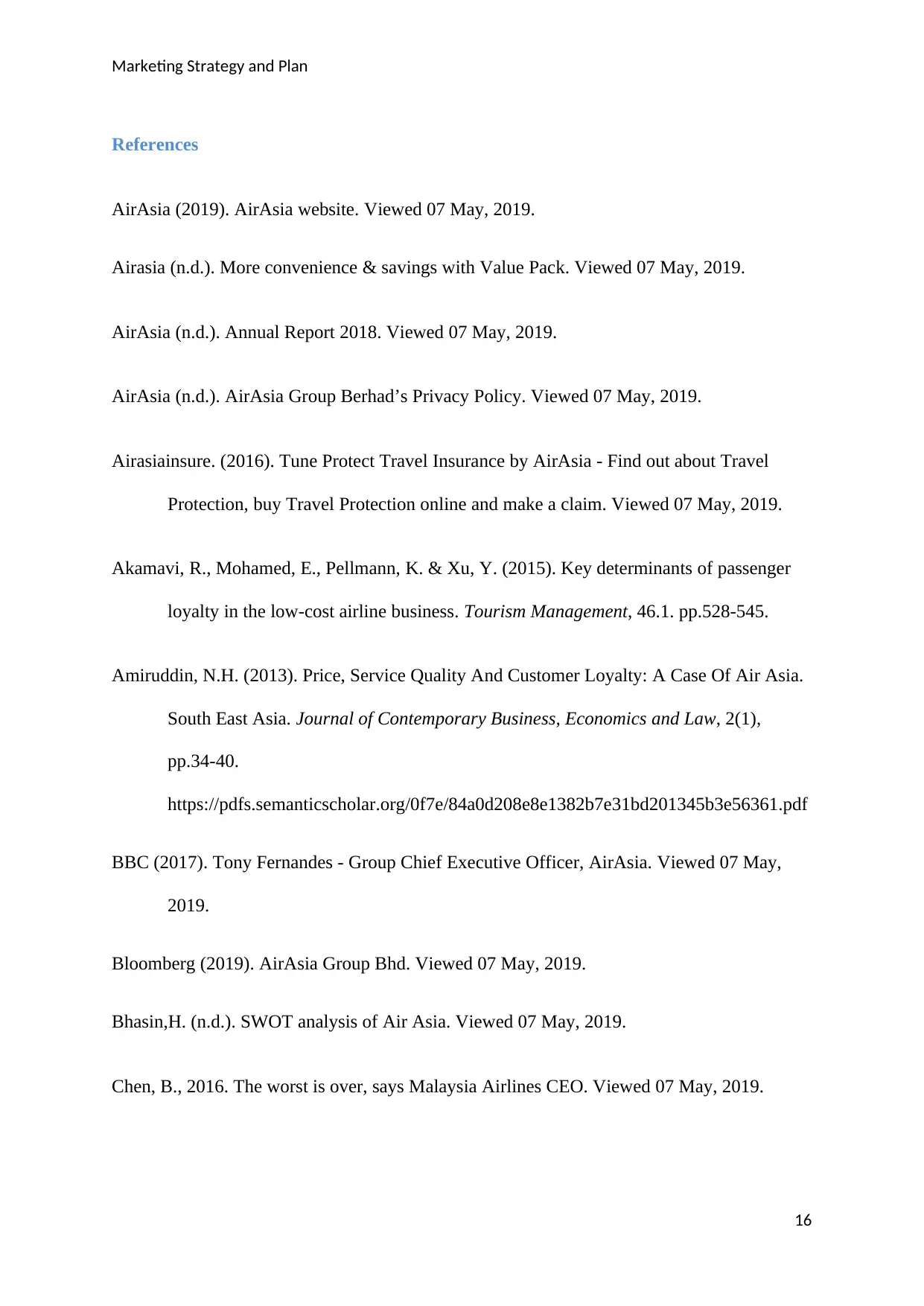
Marketing Strategy and Plan
References
AirAsia (2019). AirAsia website. Viewed 07 May, 2019.
Airasia (n.d.). More convenience & savings with Value Pack. Viewed 07 May, 2019.
AirAsia (n.d.). Annual Report 2018. Viewed 07 May, 2019.
AirAsia (n.d.). AirAsia Group Berhad’s Privacy Policy. Viewed 07 May, 2019.
Airasiainsure. (2016). Tune Protect Travel Insurance by AirAsia - Find out about Travel
Protection, buy Travel Protection online and make a claim. Viewed 07 May, 2019.
Akamavi, R., Mohamed, E., Pellmann, K. & Xu, Y. (2015). Key determinants of passenger
loyalty in the low-cost airline business. Tourism Management, 46.1. pp.528-545.
Amiruddin, N.H. (2013). Price, Service Quality And Customer Loyalty: A Case Of Air Asia.
South East Asia. Journal of Contemporary Business, Economics and Law, 2(1),
pp.34-40.
https://pdfs.semanticscholar.org/0f7e/84a0d208e8e1382b7e31bd201345b3e56361.pdf
BBC (2017). Tony Fernandes - Group Chief Executive Officer, AirAsia. Viewed 07 May,
2019.
Bloomberg (2019). AirAsia Group Bhd. Viewed 07 May, 2019.
Bhasin,H. (n.d.). SWOT analysis of Air Asia. Viewed 07 May, 2019.
Chen, B., 2016. The worst is over, says Malaysia Airlines CEO. Viewed 07 May, 2019.
16
References
AirAsia (2019). AirAsia website. Viewed 07 May, 2019.
Airasia (n.d.). More convenience & savings with Value Pack. Viewed 07 May, 2019.
AirAsia (n.d.). Annual Report 2018. Viewed 07 May, 2019.
AirAsia (n.d.). AirAsia Group Berhad’s Privacy Policy. Viewed 07 May, 2019.
Airasiainsure. (2016). Tune Protect Travel Insurance by AirAsia - Find out about Travel
Protection, buy Travel Protection online and make a claim. Viewed 07 May, 2019.
Akamavi, R., Mohamed, E., Pellmann, K. & Xu, Y. (2015). Key determinants of passenger
loyalty in the low-cost airline business. Tourism Management, 46.1. pp.528-545.
Amiruddin, N.H. (2013). Price, Service Quality And Customer Loyalty: A Case Of Air Asia.
South East Asia. Journal of Contemporary Business, Economics and Law, 2(1),
pp.34-40.
https://pdfs.semanticscholar.org/0f7e/84a0d208e8e1382b7e31bd201345b3e56361.pdf
BBC (2017). Tony Fernandes - Group Chief Executive Officer, AirAsia. Viewed 07 May,
2019.
Bloomberg (2019). AirAsia Group Bhd. Viewed 07 May, 2019.
Bhasin,H. (n.d.). SWOT analysis of Air Asia. Viewed 07 May, 2019.
Chen, B., 2016. The worst is over, says Malaysia Airlines CEO. Viewed 07 May, 2019.
16
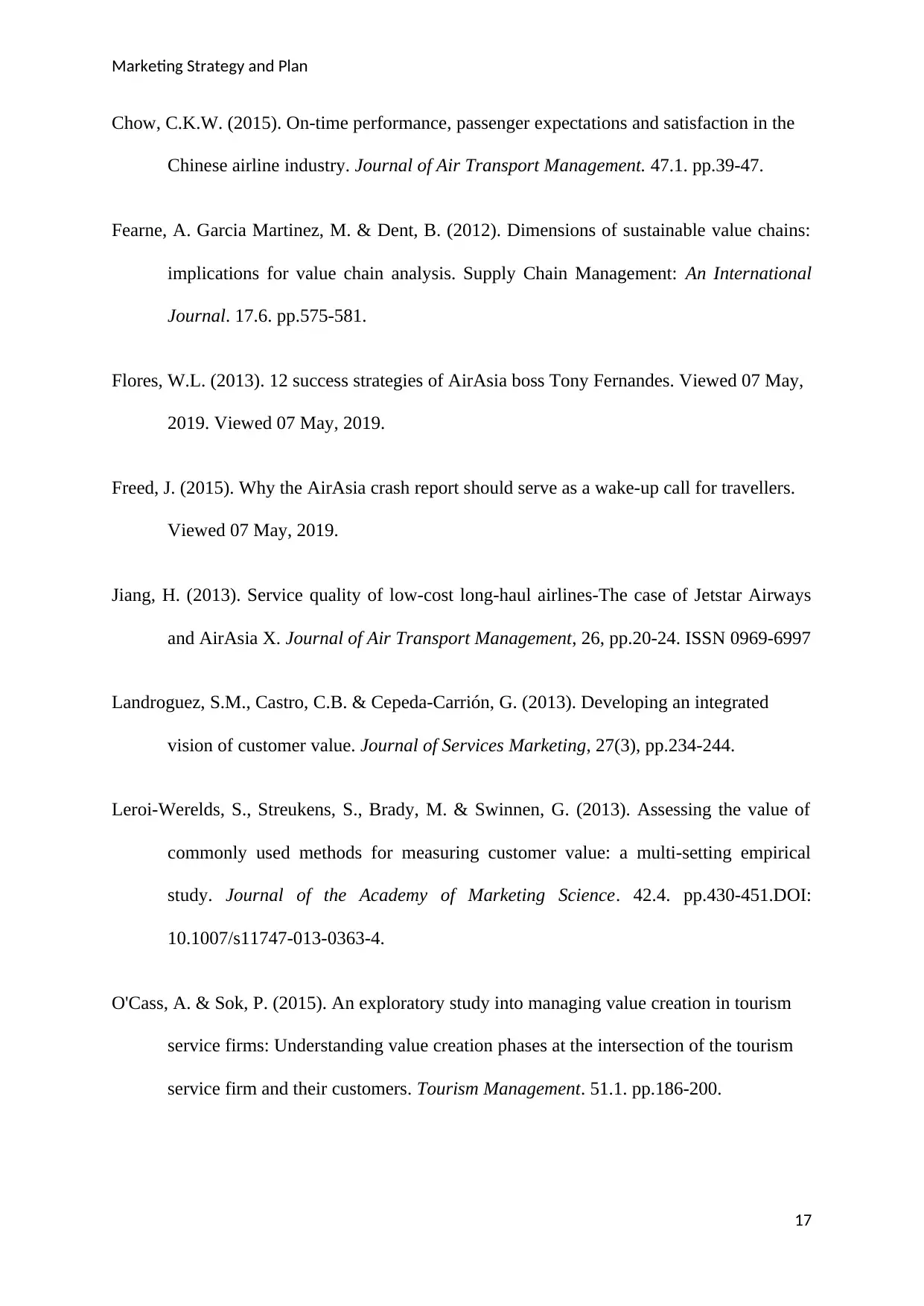
Marketing Strategy and Plan
Chow, C.K.W. (2015). On-time performance, passenger expectations and satisfaction in the
Chinese airline industry. Journal of Air Transport Management. 47.1. pp.39-47.
Fearne, A. Garcia Martinez, M. & Dent, B. (2012). Dimensions of sustainable value chains:
implications for value chain analysis. Supply Chain Management: An International
Journal. 17.6. pp.575-581.
Flores, W.L. (2013). 12 success strategies of AirAsia boss Tony Fernandes. Viewed 07 May,
2019. Viewed 07 May, 2019.
Freed, J. (2015). Why the AirAsia crash report should serve as a wake-up call for travellers.
Viewed 07 May, 2019.
Jiang, H. (2013). Service quality of low-cost long-haul airlines-The case of Jetstar Airways
and AirAsia X. Journal of Air Transport Management, 26, pp.20-24. ISSN 0969-6997
Landroguez, S.M., Castro, C.B. & Cepeda‐Carrión, G. (2013). Developing an integrated
vision of customer value. Journal of Services Marketing, 27(3), pp.234-244.
Leroi-Werelds, S., Streukens, S., Brady, M. & Swinnen, G. (2013). Assessing the value of
commonly used methods for measuring customer value: a multi-setting empirical
study. Journal of the Academy of Marketing Science. 42.4. pp.430-451.DOI:
10.1007/s11747-013-0363-4.
O'Cass, A. & Sok, P. (2015). An exploratory study into managing value creation in tourism
service firms: Understanding value creation phases at the intersection of the tourism
service firm and their customers. Tourism Management. 51.1. pp.186-200.
17
Chow, C.K.W. (2015). On-time performance, passenger expectations and satisfaction in the
Chinese airline industry. Journal of Air Transport Management. 47.1. pp.39-47.
Fearne, A. Garcia Martinez, M. & Dent, B. (2012). Dimensions of sustainable value chains:
implications for value chain analysis. Supply Chain Management: An International
Journal. 17.6. pp.575-581.
Flores, W.L. (2013). 12 success strategies of AirAsia boss Tony Fernandes. Viewed 07 May,
2019. Viewed 07 May, 2019.
Freed, J. (2015). Why the AirAsia crash report should serve as a wake-up call for travellers.
Viewed 07 May, 2019.
Jiang, H. (2013). Service quality of low-cost long-haul airlines-The case of Jetstar Airways
and AirAsia X. Journal of Air Transport Management, 26, pp.20-24. ISSN 0969-6997
Landroguez, S.M., Castro, C.B. & Cepeda‐Carrión, G. (2013). Developing an integrated
vision of customer value. Journal of Services Marketing, 27(3), pp.234-244.
Leroi-Werelds, S., Streukens, S., Brady, M. & Swinnen, G. (2013). Assessing the value of
commonly used methods for measuring customer value: a multi-setting empirical
study. Journal of the Academy of Marketing Science. 42.4. pp.430-451.DOI:
10.1007/s11747-013-0363-4.
O'Cass, A. & Sok, P. (2015). An exploratory study into managing value creation in tourism
service firms: Understanding value creation phases at the intersection of the tourism
service firm and their customers. Tourism Management. 51.1. pp.186-200.
17

Marketing Strategy and Plan
Payne, A. & Frow, P. (2014). Developing superior value propositions: a strategic marketing
imperative. Journal of Service Management. 25(2), pp.213-227.
Porter, M.E. (2012). Strategic Positioning in a Challenging World: Creating Shared Value.
www.hbs.edu/faculty/Pages/download.aspx?name=20120928%20-%20Porter
%20Prize%20India%20Str-CSV%20Presentation%20-%20Final%20-%20.pdf
Ryu, K., Lee, H.R. & Kim, W.G. (2012). The influence of the quality of the physical
environment, food, and service on restaurant image, customer perceived value,
customer satisfaction, and behavioral intentions. International Journal of
Contemporary Hospitality Management. 24.2. pp.200-223.
Sengupta, A.S, Balaji, M.S. & Krishnan, B.C. (2015). How customers cope with service
failure? A study of brand reputation and customer satisfaction. Journal of Business
Research. 68.3. pp.665-674. Viewed 07 May, 2019.
Skyscanner (n.d.). AirAsia Flights. Viewed 07 May, 2019.
Skok, M. (2013). 4 Steps To Building A Compelling Value Proposition. Viewed 07 May,
2019. https://www.forbes.com/sites/michaelskok/2013/06/14/4-steps-to-building-a-
compelling-value-proposition/#5db87a764695
Sultan, A. & Saurabh. (2013). Achieving Sustainable Development through Value Chain.
International Journal of Managing Value and Supply Chains. 4.2. pp.39-46. DOI:
10.5121/ijmvsc.2013.4204.
Thestar. (2016). Malaysia Airlines to launch new passenger service system. Viewed 07 May,
2019.
18
Payne, A. & Frow, P. (2014). Developing superior value propositions: a strategic marketing
imperative. Journal of Service Management. 25(2), pp.213-227.
Porter, M.E. (2012). Strategic Positioning in a Challenging World: Creating Shared Value.
www.hbs.edu/faculty/Pages/download.aspx?name=20120928%20-%20Porter
%20Prize%20India%20Str-CSV%20Presentation%20-%20Final%20-%20.pdf
Ryu, K., Lee, H.R. & Kim, W.G. (2012). The influence of the quality of the physical
environment, food, and service on restaurant image, customer perceived value,
customer satisfaction, and behavioral intentions. International Journal of
Contemporary Hospitality Management. 24.2. pp.200-223.
Sengupta, A.S, Balaji, M.S. & Krishnan, B.C. (2015). How customers cope with service
failure? A study of brand reputation and customer satisfaction. Journal of Business
Research. 68.3. pp.665-674. Viewed 07 May, 2019.
Skyscanner (n.d.). AirAsia Flights. Viewed 07 May, 2019.
Skok, M. (2013). 4 Steps To Building A Compelling Value Proposition. Viewed 07 May,
2019. https://www.forbes.com/sites/michaelskok/2013/06/14/4-steps-to-building-a-
compelling-value-proposition/#5db87a764695
Sultan, A. & Saurabh. (2013). Achieving Sustainable Development through Value Chain.
International Journal of Managing Value and Supply Chains. 4.2. pp.39-46. DOI:
10.5121/ijmvsc.2013.4204.
Thestar. (2016). Malaysia Airlines to launch new passenger service system. Viewed 07 May,
2019.
18
Paraphrase This Document
Need a fresh take? Get an instant paraphrase of this document with our AI Paraphraser
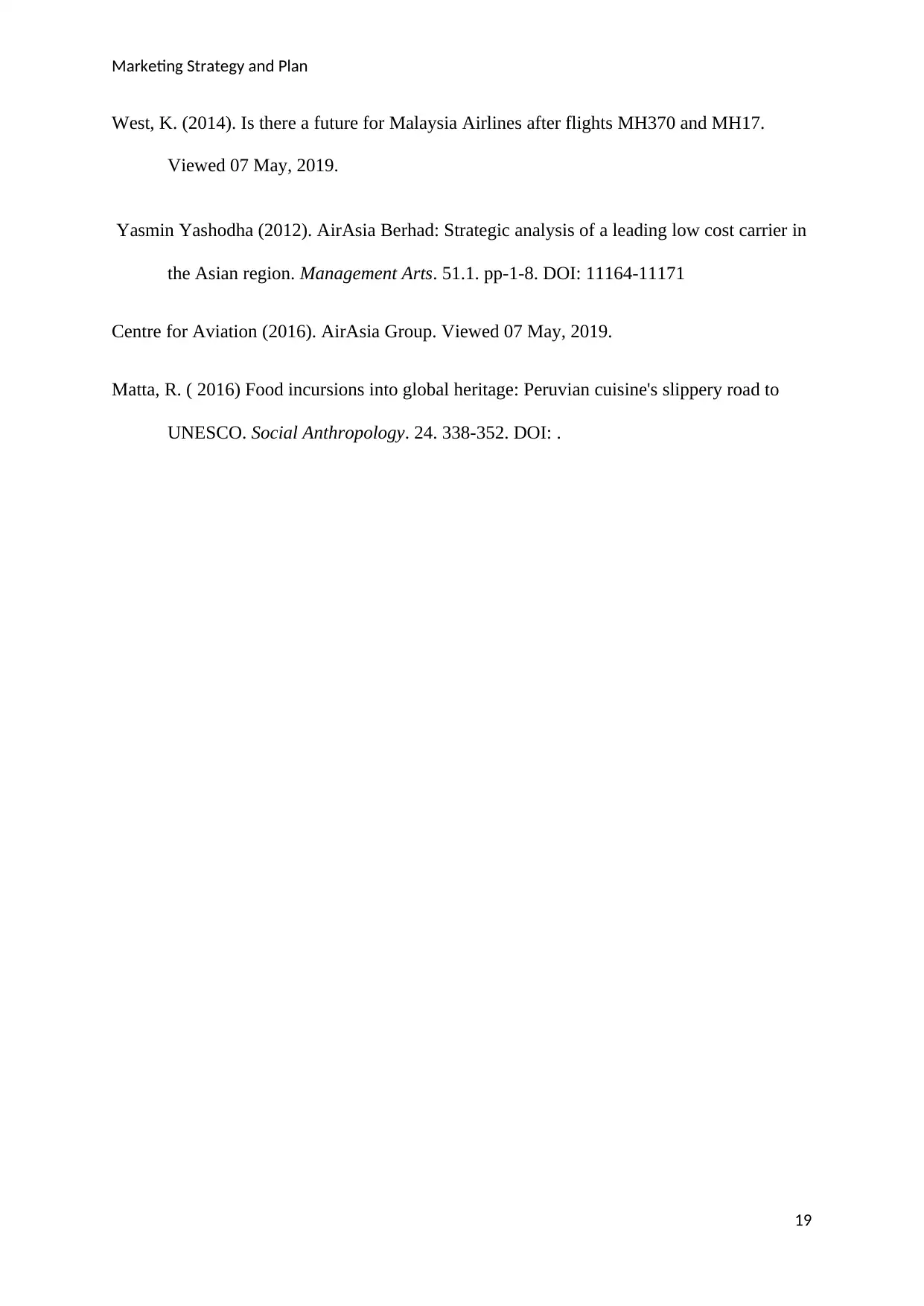
Marketing Strategy and Plan
West, K. (2014). Is there a future for Malaysia Airlines after flights MH370 and MH17.
Viewed 07 May, 2019.
Yasmin Yashodha (2012). AirAsia Berhad: Strategic analysis of a leading low cost carrier in
the Asian region. Management Arts. 51.1. pp-1-8. DOI: 11164-11171
Centre for Aviation (2016). AirAsia Group. Viewed 07 May, 2019.
Matta, R. ( 2016) Food incursions into global heritage: Peruvian cuisine's slippery road to
UNESCO. Social Anthropology. 24. 338-352. DOI: .
19
West, K. (2014). Is there a future for Malaysia Airlines after flights MH370 and MH17.
Viewed 07 May, 2019.
Yasmin Yashodha (2012). AirAsia Berhad: Strategic analysis of a leading low cost carrier in
the Asian region. Management Arts. 51.1. pp-1-8. DOI: 11164-11171
Centre for Aviation (2016). AirAsia Group. Viewed 07 May, 2019.
Matta, R. ( 2016) Food incursions into global heritage: Peruvian cuisine's slippery road to
UNESCO. Social Anthropology. 24. 338-352. DOI: .
19
1 out of 20
Related Documents
Your All-in-One AI-Powered Toolkit for Academic Success.
+13062052269
info@desklib.com
Available 24*7 on WhatsApp / Email
![[object Object]](/_next/static/media/star-bottom.7253800d.svg)
Unlock your academic potential
© 2024 | Zucol Services PVT LTD | All rights reserved.





